LTR Training Tip #1: Training Donkeys
Meredith gets a lot of letters and emails from people with training questions about their equines. Here, she offers some practical advice for training your donkeys.
Posts to share on the LTR blog

Meredith gets a lot of letters and emails from people with training questions about their equines. Here, she offers some practical advice for training your donkeys.


It was the first week in December. The trees had long since lost their brilliant fall colors, the grass had turned to brown, and the air held the chill of winter. The mules, donkeys, and horses of the Lucky Three breeding farm basked in the peaceful morning sun, awaiting their morning feeding. We made the rounds, checking each animal and were surprised to come upon our jack, Lucky Three Excalibur, otherwise known as “Zee,” in a very depressed state. This was not normal for him and caused us some concern. Zee was a very special Mammoth donkey jack. His grandsire, Little Jack Horner had been famous for the production of refined, attractive and horse-like saddle mules. For years, we searched for just the right jennets to begin producing Mammoth jackstock that would carry on this tradition. However, Little Jack Horner kept producing daughters from the jennets. Finally, we bred L.J.’s three daughters to another fine jack, Blue Zebulon from the Bitterroot Mule Company and each of them had a jack colt. Lucky Three Excalibur was the finest of the three jack colts. He was tall, refined, black, and beautiful! He was the successful culmination of years of breeding research and implementation of the knowledge we gained.
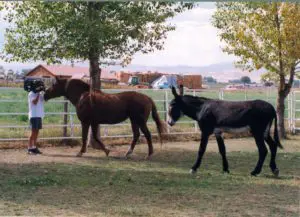 No other was as loving, affectionate, and willing as Zee! His ground training went smoothly and he was trained to breed in hand with no difficulties. Clients were exceptionally pleased with his offspring and he went on to become a star. Zee was actually broke to ride while shooting the donkey training videos for the Training Mules and Donkeys video series. Zee’s career soared when the videos were revised for television and he obtained a starring role in the making of the Discovery Channel’s “The Ultimate Horse.” If he was born handsome, he grew to be even more magnificent. In adulthood, he matured to 15.2 hands sporting the shiniest black coat and incredibly good conformation for a Mammoth donkey.
No other was as loving, affectionate, and willing as Zee! His ground training went smoothly and he was trained to breed in hand with no difficulties. Clients were exceptionally pleased with his offspring and he went on to become a star. Zee was actually broke to ride while shooting the donkey training videos for the Training Mules and Donkeys video series. Zee’s career soared when the videos were revised for television and he obtained a starring role in the making of the Discovery Channel’s “The Ultimate Horse.” If he was born handsome, he grew to be even more magnificent. In adulthood, he matured to 15.2 hands sporting the shiniest black coat and incredibly good conformation for a Mammoth donkey.
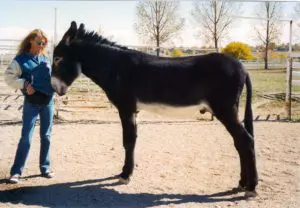
When I saw him standing so depressed, I thought about the years that went into his making and hoped this wouldn’t be more than a mild colic. We called our vet who came out and did a complete checkup. He said he wasn’t really sure what was going on with him, but it wasn’t colic and after a week with no change, he suggested that we take him to Colorado State Veterinary Teaching Hospital for further examination. Trooper that he was, Zee loaded easily, but it was evident that he was in distress.
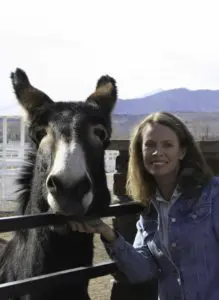 Zee was presented to the Colorado State Veterinary Hospital in Fort Collins with a history of being off his feed for almost a week. At the hospital, they did a barrage of testing and diagnosed him with “idiopathic hematuria and interstitial nephritis.” At this point his prognosis was only fair. Physical exam findings and laboratory results revealed that Zee initially was presented with “signs of mild hematuria and azotemia (decreased renal function). His kidney enzymes were increased in his blood and he had an inflammatory complete blood count. He passed blood-tinged manure on several occasions, but this resolved itself. He was treated with antibiotics, anti-ulcer medications and intravenous fluids. Over the course of his hospitalization, his attitude and appetite improved as his azotemia improved. He was removed from intravenous fluids when his creatinine stabilized at about three.”
Zee was presented to the Colorado State Veterinary Hospital in Fort Collins with a history of being off his feed for almost a week. At the hospital, they did a barrage of testing and diagnosed him with “idiopathic hematuria and interstitial nephritis.” At this point his prognosis was only fair. Physical exam findings and laboratory results revealed that Zee initially was presented with “signs of mild hematuria and azotemia (decreased renal function). His kidney enzymes were increased in his blood and he had an inflammatory complete blood count. He passed blood-tinged manure on several occasions, but this resolved itself. He was treated with antibiotics, anti-ulcer medications and intravenous fluids. Over the course of his hospitalization, his attitude and appetite improved as his azotemia improved. He was removed from intravenous fluids when his creatinine stabilized at about three.”
“Shortly thereafter, the hematuria worsened and he was urinating large amounts of frank blood. Bladder endoscopy initially revealed urine coming from both ureters, but over time, the hematuria worsened endoscopy revealed that the blood was originating from the left kidney and the right kidney was not producing much urine. A biopsy of the right kidney revealed an interstitial nephritis (inflammation) with signs of regeneration. The bleeding continued and Zee’s pack cell volume fell to 10% necessitating a transfusion.”
Back at the ranch, Little Jack Horner knew something was really wrong. My face and demeanor must have said volumes. I had been to the vet hospital everyday, spending at least an hour with Zee, brushing, massaging, talking and doing everything I could think of to keep up his spirits. He was nearly immobile, but on good days, we could take a short walk. He was so weak, even the short walks were laborious. He would stop and put his head down to consider nibbling the dried grass, but quickly gave up the effort. He would have to stop and rest after only a few steps. He had dropped over 100 pounds of body weight. It was apparent…he was dying.
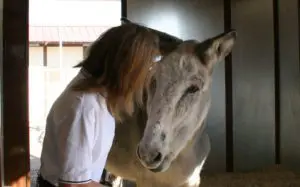 I told Little Jack Horner that this day he would have a very important mission. He was the best choice for the blood transfusion to his grandson. L.J. seemed to understand and gave me no trouble when I loaded him into the trailer and took him to the vet hospital. When we arrived, they asked if we needed to sedate him. All I had to do was look at him to know he was going to be a trooper, too. No sedation was necessary. L.J. stood like the champion he was while they extracted pints and pints of blood from him. I let L.J. know how grateful I was for his contribution to his grandson’s health. He was quietly appreciative.
I told Little Jack Horner that this day he would have a very important mission. He was the best choice for the blood transfusion to his grandson. L.J. seemed to understand and gave me no trouble when I loaded him into the trailer and took him to the vet hospital. When we arrived, they asked if we needed to sedate him. All I had to do was look at him to know he was going to be a trooper, too. No sedation was necessary. L.J. stood like the champion he was while they extracted pints and pints of blood from him. I let L.J. know how grateful I was for his contribution to his grandson’s health. He was quietly appreciative.
The days immediately following the transfusion, Zee seemed to improve, and then crashed again. A renal nuclear scan revealed that the left kidney was producing the majority of the urine, but that the right kidney was functional. This made removal of the left kidney impractical.
The vet hospital told me that there wasn’t much hope and that I would probably have to make “a decision.” I knew what they meant, but I wasn’t ready to give up quite yet. I believe in miracles and I also believe in exhausting every possible avenue of hope. I had but one last long shot left. I asked the hospital if they would mind if I brought in my equine chiropractor/acupuncturist, David McClain. Since there was no more they could do for Zee, they agreed. Dr. McClain treated Zee three different times at the hospital over a period of days. Zee was monitored daily for a falling hemocrit and periodically creatinine measurements and complete blood counts were performed. Zee was removed from antibiotics when his blood count normalized. On January 11, 2000, Zee’s urine no longer contained frank blood and he was observed for two more days and then discharged.
It was almost comical the day he was discharged. When I arrived with the trailer to take him home, doctors, vet techs, students and a hoard of others emerged from the hospital to see him off. It was incredible to see the number of friends that Zee had made during his stay. Each of them had tears of happiness on their faces knowing how close to death he had come.
 We monitored Zee very closely for the next year and he steadily improved. We can really only guess what caused all this, but the most reasonable assumption would be that he wrenched his back after covering a mare, pinched the blood supply to the kidneys and caused a secondary infection. Manipulation and acupuncture by the equine chiropractor relieved the pressure and promoted healing. There was a great deal of trauma to his body and we still weren’t sure he would really make it back to normal with his kidneys being so compromised, but did make it through and was happy and healthy for several more years. You would never know he had been through so much.
We monitored Zee very closely for the next year and he steadily improved. We can really only guess what caused all this, but the most reasonable assumption would be that he wrenched his back after covering a mare, pinched the blood supply to the kidneys and caused a secondary infection. Manipulation and acupuncture by the equine chiropractor relieved the pressure and promoted healing. There was a great deal of trauma to his body and we still weren’t sure he would really make it back to normal with his kidneys being so compromised, but did make it through and was happy and healthy for several more years. You would never know he had been through so much.
Zee’s illness brought a lot of people together, sharing the things that each had to offer. If I had learned nothing, I had learned to value what others have to offer, no matter how insignificant it may seem. When we share who we are, we can create miracles. Zee shared his miracle with all of us and it resulted in the donkey training books and videos that I have produced to share with the world!
To learn more about Meredith Hodges and her comprehensive all-breed equine training program, visit LuckyThreeRanch.com, MEREDITH HODGES PUBLIC FIGURE Facebook page, or call 1-800-816-7566. Check out her children’s website at JasperTheMule.com. Also, find Meredith on Pinterest, Instagram, MeWe, YouTube and Twitter.
Covered in TRAINING MULES & DONKEY: A LOGICAL APPROACH TO TRAINING, TRAINING WITHOUT RESISTANCE and EQUUS REVISITED at www.luckythreeranchstore.com.
© 2003, 2016, 2024 Lucky Three Ranch, Inc. All Rights Reserved.



AUGIE & SPUDS: SNOWPLAY…A FABULOUS SNOW DAY! No matter what season it is, there is always a way to turn training into fun with your equines. Usually, Augie and Spuds will just stand in their stalls when there is snow on the ground. I suppose they don’t like getting their feet wet and their stall is a nice, comfortable place with deep shavings. They do enjoy my encouragement to go exploring though, even if they have to get their feet wet! See more adventures with Augie and Spuds on my website at www.luckythreeranch.com under TRAINING/ANOTHER AUGIE & SPUDS ADVENTURE.
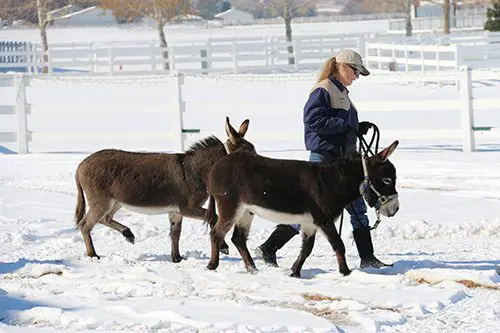
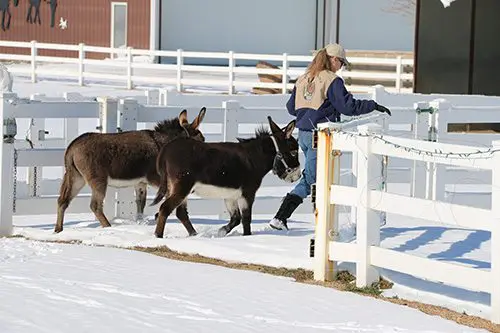
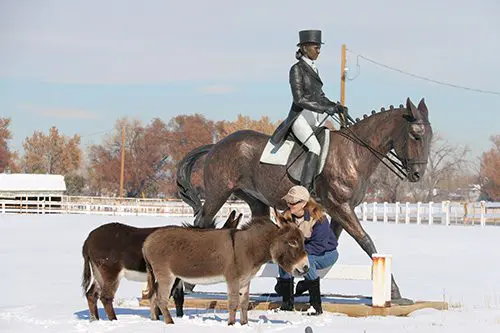

I decided to take them to the North Pasture this morning to play where the Lucky Three Sundowner bronze sculpture is situated. After going through the gate the way they were trained to do, I removed their halters and began our play session by asking them to come and see the statue. I was able to Get Down with my Minis by sitting on the base, then slid to my knees into the snow. Spuds scoped out the area while I “shook hands” with Augie. Spuds can be ornery, so he might have been saying to me, “Kiss my ass. I’m not shaking hands right now!” BUT…I just ignore the bad, or questionable, behaviors! At least he isn’t running off!
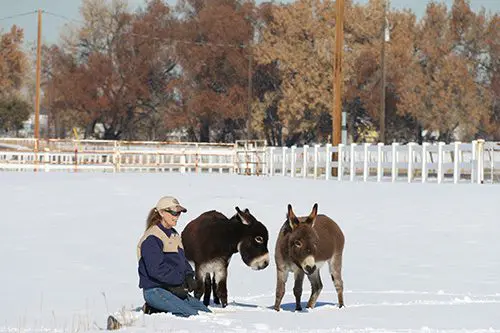
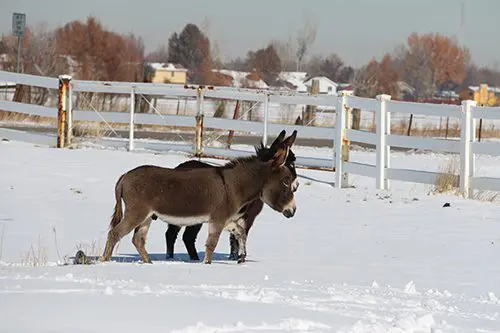
Next, I went to the middle of the pasture and dropped to my knees. Then I gave them permission to go exploring.
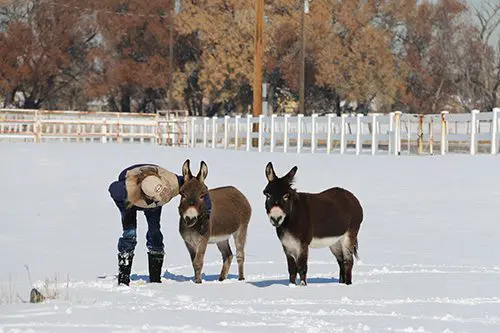
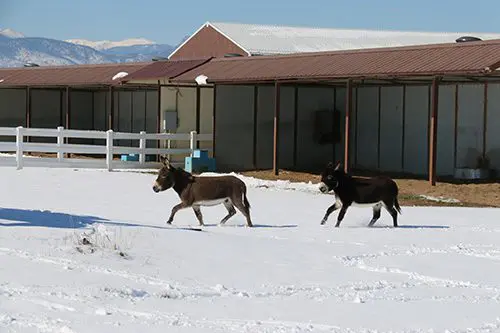
After scoping out what was on the other side of the road, they returned. I got up and quickly ran to the fence on the south side and called them to me. When they arrived, I “shook their hands” and gave them their reward of crimped oats. Although Spuds was a bit reluctant at first, he complied this time. Augie is ALWAYS willing to do what I ask!
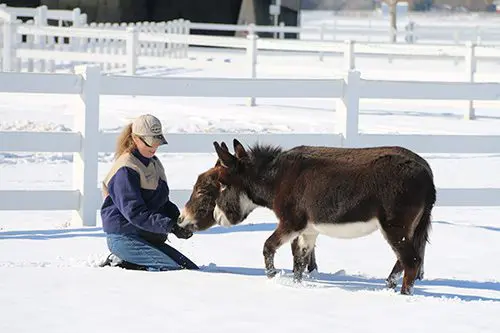
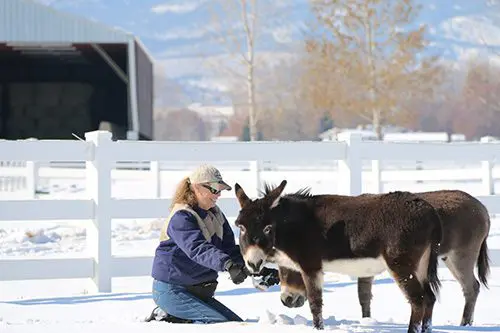
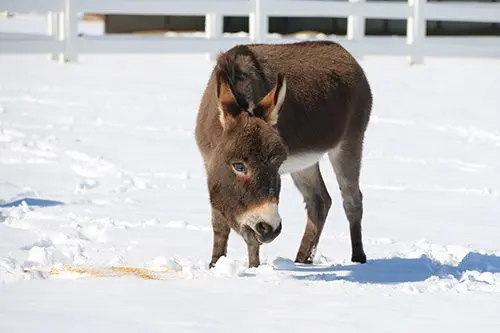
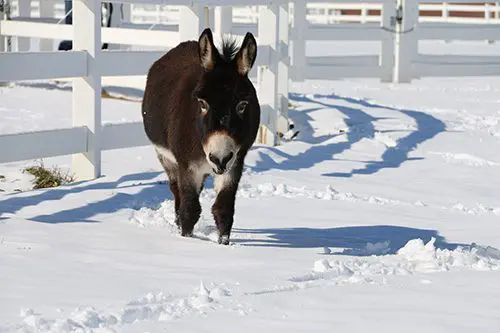
I allowed them to mosey around for a little longer. They thought the snow was pretty cool after that!
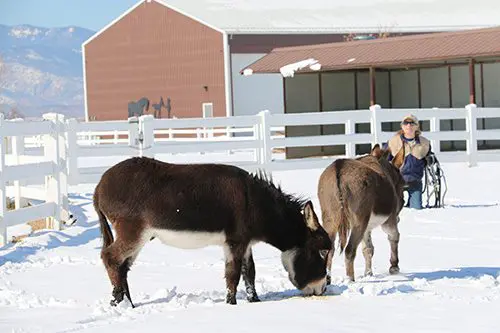
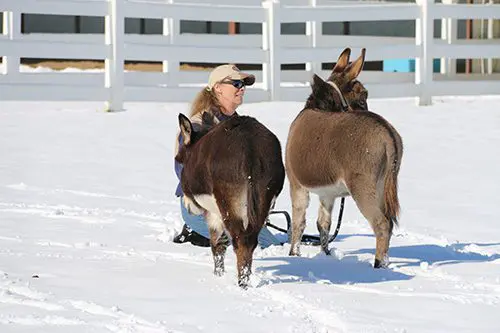
Then I dropped to my knees again near the gate, called them over and put on their halters. They were PERFECT!
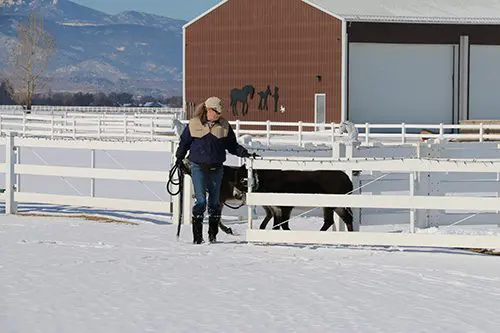
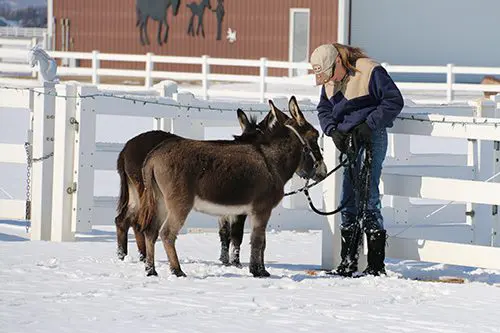
It was time to execute the gate properly again and head back to the barn…what fun on a sunny winter day!
To learn more about Meredith Hodges and her comprehensive all-breed equine training program, visit LuckyThreeRanch.com or call 1-800-816-7566. Check out her children’s website at JasperTheMule.com. Also, find Meredith on Facebook, YouTube and Twitter.
© 2016, 2017 Lucky Three Ranch, Inc. All Rights Reserved.

We hope you enjoy this intriguing and inspiring article that was submitted by one of our contributing writers, Tara Edwards, Trimepil:

Sometimes, miracles do happen. Such was the case in the not so distant 1976, when a proper underdog proved to be better than the competition. The competition being over 198 champion horses who were gunning for the title. A simple mule came out on top when put against some of the most treasured horses from all over the world.
But was this outcome truly miraculous, or was it a result of something else? Could this result be predicted? Let’s find out.
The Setup
In the days when America enjoyed their two hundred years of independence, the beauties of the country were put on display. Simple celebration of the country and its treasures wasn’t quite enough though, because patriotism reached its peak and had to be expressed properly. This lead to the organization of a few very interesting and unique events. One of these events, or setups was the Freedom Train. This train was practically a museum which moved along on the railways. It went through 48 states on its journey across the state, allowing millions of people to see it and enjoy its presentation. Another kind of event that took place often in these times were nautical parades. Some of the most fascinating and biggest ships, along with their smaller partners set out and traveled along the coastline, all the while carrying large patriotic flags. Love for the country and its freedom didn’t end there, every company that could, tried their best to express their unwavering loyalty to the flag. Railroad companies decided to paint their entire trains into red, white and blue so that state flags could go all around the railroads, bringing joy to any who see them.
Amidst all this commotion, a competitive event took place. One which allowed anyone with a couple of horses, $500, and a resolute adventurous spirit to try their luck. The Great American Horse Race, as it was called, was brought to life by a pair of horse loving salesmen, Chuck Waggoner and Randy Scheiding. The prize was pretty generous, reaching $25,000, but that wasn’t the greatest motivation for most competitors. This was a chance to prove the worth of a horse, and to gain fame and reputation. But to achieve that, one would have to travel 3,500 miles over fourteen weeks across America on the back of their trustworthy steed. Some of the trails the contestants would experience were the Oregon Trail, the Pony Express Trail, and the Donner Party’s doomed journey. This journey presented a unique possibility to get familiar with the wild beauty of 13 states up close while enjoying a bit of healthy rivalry against the opponents.
The Competition
This race turned out to be very appealing and fascinating, attracting people from all over the world, not just America. Such a result wasn’t surprising though, because this competition was in fact a chance for horse breeders of all sorts to demonstrate their horse’s worth, beauty and uniqueness. Over 90 teams applied (each allowed two horses), most of them hoping and believing they will prove that their horse was indeed, the best of the best.
Of course, some were in it just for fun, having entered without much hope of winning. Others were really serious about the race, bringing treasured horses with great heritage behind them. From 18 year old singer, to 69 year old horse trader, with pediatricians, students, cowboys, nurses, and at least one university president, they all tried their luck on this race.
The only Russian Orlov stallion in America, called Nature’s Ballet, descendant from a horse that belonged to Nikita Kruschev entered the race, being ridden by one Californian. Iceland sent over ten Viking high born horses to compete, but only after they had altitude training in San Francisco. France sent over a dozen horsemen dressed like Marquis Lafayette’s soldiers. Competition came from Australia, Denmark and even Japan, all believing that their horses would came out on top.
The Feat
One contestant was a bit different than the rest because he did not come with horses that were high born or had great descendants. All rides were allowed to enter the race with two horses, one being a backup horse in case the main steed couldn’t ride anymore. Virl Norton, a 54 year old steeplejack from San Jose, California, decided that both of his horses would be his loyal mules. He considered them precious just as much as any other contestant considered their horse to be special. With great confidence, he entered the race strongly believing that his mules were the most adequate choice for this exhausting long race. Norton was a kind hearted man, with no grudges with the other competitors. A few days before the race, he gave his second mount, Deacon, to a contestant whose horse got injured.
The race was unbelievably demanding, burning through 18,000 horseshoes in total. Despite the slow pace and the obligatory vet checks every 10 miles, some of the main mounts went lame and were swapped for the backups. Some of the backups also went lame.
Most riders considered Norton an honorable man because he wouldn’t think twice about helping other contestants when they had troubles. He let people take photos with his mule Leeroy and he’d make up the time lost by skipping water stops. Leeroy was considered a puppy dog mule due to his calm temper and composure. After some time, Norton’s backup mule Lady Eloise suffered an injury and had to withdraw from race, but Leeroy and Norton kept riding, taking it slow and easy during their journey.
Norton was the 31st rider to pass the finish line, but that didn’t mean he was far from victory. In fact, Leeroy even flapped his ears as they reached the goal, celebrating their success long before the results came out. After the judges calculated the total score of all contestants by measuring their riding time and applying the penalties, the winner was declared. Norton and Leeroy came out on top with 315.47 hours in the saddle, ahead of an Arabian in second place with 324.6 hours riding time. Top ten horses were basically show steeds, with two exceptions, Leeroy and Deacon, who were mules.
Norton wasn’t surprised by this result, stating that the other horses had no chance against his mules. He took the grand prize and henceforth called himself The Great American Horseman. Lord Fauntleroy, which was Leeroy’s full name, was known as The Great American Horse after that.
Sometimes the underdog is in fact the favorite, but only they know that. Norton and Leeroy proved that.
Links:

By Meredith Hodges
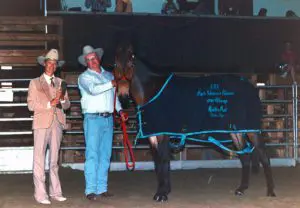 Being asked to judge a show is both an honor and a tremendous responsibility. Just being asked to judge indicates that you have a reputation for being a knowledgeable and respected person in your field of expertise. Accepting the invitation to judge means that you are willing to share this knowledge and expertise with people who may, or may not, accept IT or you! Exhibitors can say that each show reflects only one “man’s” (judge’s) opinion, so not to worry if you don’t do well. As an exhibitor and a judge, this bothers me a little.
Being asked to judge a show is both an honor and a tremendous responsibility. Just being asked to judge indicates that you have a reputation for being a knowledgeable and respected person in your field of expertise. Accepting the invitation to judge means that you are willing to share this knowledge and expertise with people who may, or may not, accept IT or you! Exhibitors can say that each show reflects only one “man’s” (judge’s) opinion, so not to worry if you don’t do well. As an exhibitor and a judge, this bothers me a little.
If the basics of Horsemanship, or Mulemanship, remain constant, then the consistency among judges should also remain fairly consistent with only a little variation from judge to judge. The variation in placements should be determined by the performance of t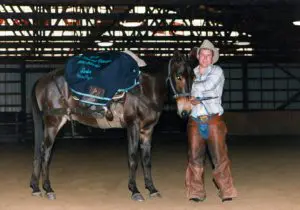 he exhibitors and not by the personal opinions of the judge. The judge should be a catalyst toward better learning and performance. He or she should try to make their knowledge readily available to inquiring exhibitors and be diplomatic enough about its delivery to inspire and encourage exhibitors to improve their skills. In turn, the exhibitors will be better equipped to exhibit their animals in a favorable light to the public at large and to grow into knowledgeable experts themselves with time and experience.
he exhibitors and not by the personal opinions of the judge. The judge should be a catalyst toward better learning and performance. He or she should try to make their knowledge readily available to inquiring exhibitors and be diplomatic enough about its delivery to inspire and encourage exhibitors to improve their skills. In turn, the exhibitors will be better equipped to exhibit their animals in a favorable light to the public at large and to grow into knowledgeable experts themselves with time and experience.
A good judge serves three major interests: that of his own conscience, that of his exhibitors, and that of the spectators. He must know all the rules and regulations pertaining to the classes to be judged and be willing to select the best animals for the purpose described by the conditions of the classes. He should be 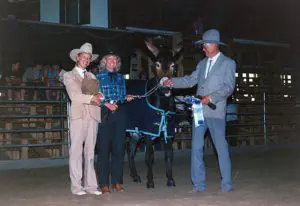 objective in his decisions and be able to back them up with reasonable and knowledgeable explanations that will inspire exhibitors to work harder and learn more. He should have a congenial attitude that invites exhibitors to question and learn freely without intimidation.
objective in his decisions and be able to back them up with reasonable and knowledgeable explanations that will inspire exhibitors to work harder and learn more. He should have a congenial attitude that invites exhibitors to question and learn freely without intimidation.
Judges are human too, and for this reason judges are restricted from judging people and animals that are in some manner closely related to him. This enables the judge to maintain his objectivity and adds more 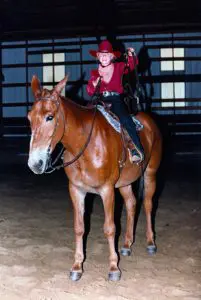 credence to his final decisions. In my opinion, judges should assist in helping exhibitors realize their full potential by helping them to improve their skills through fair, just, and educated decisions. A good judge needs to serve the idea of better learning for the sake of health, wealth, happiness, and above all, safety! A judge can be the catalyst toward learning and self-satisfaction, or he can be the catalyst toward defeat and discouragement. I prefer to be the former, encouraging exhibitors to come to me with their questions and also encouraging them to learn from each other. In our Longears industry, the ideal scenario would be to have exhibitors work at home and with each other perfecting their Mulemanship skills, bring those exhibitions of skills to a show to be judged, then return home with a feeling of accomplishment and more things to work on until the next show and the next judge. To perpetuate the learning process and to continue to learn and improve himself should be a judge’s main objective.
credence to his final decisions. In my opinion, judges should assist in helping exhibitors realize their full potential by helping them to improve their skills through fair, just, and educated decisions. A good judge needs to serve the idea of better learning for the sake of health, wealth, happiness, and above all, safety! A judge can be the catalyst toward learning and self-satisfaction, or he can be the catalyst toward defeat and discouragement. I prefer to be the former, encouraging exhibitors to come to me with their questions and also encouraging them to learn from each other. In our Longears industry, the ideal scenario would be to have exhibitors work at home and with each other perfecting their Mulemanship skills, bring those exhibitions of skills to a show to be judged, then return home with a feeling of accomplishment and more things to work on until the next show and the next judge. To perpetuate the learning process and to continue to learn and improve himself should be a judge’s main objective.
The Mule Skinner’s Classic held June 30-July 1 in Haines, Oregon, was a good example about what I am talking. Never before have I encountered an entire division of youth with such a thirst for knowledge and a desire for good sportsmanship, no doubt inspired by the adults. Application of good Mulemanship skills was prevalent and 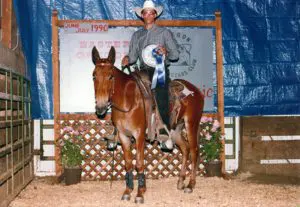 the mules and donkeys reflected this exceptional conditioning, care and handling. The show itself was obviously handled carefully and with attention to detail, leaving little margin for error or dispute. It is not really too surprising that a group such as this was able to elicit tremendous support from sponsors in their area. Their hard work and hospitality is to be appreciated and congratulated. It said a lot for the kind of people that we have in our industry – that we can all have a good time learning and showing together with our marvelous Longears, amateurs and professionals, exhibitors and judges alike! The whole idea is that each and every one of us has something to offer and something we can learn. To attend a show and to learn something new is to return home renewed and fulfilled, even though you haven’t won. To win without this mutual admiration, goodwill and learning is just another hollow victory!
the mules and donkeys reflected this exceptional conditioning, care and handling. The show itself was obviously handled carefully and with attention to detail, leaving little margin for error or dispute. It is not really too surprising that a group such as this was able to elicit tremendous support from sponsors in their area. Their hard work and hospitality is to be appreciated and congratulated. It said a lot for the kind of people that we have in our industry – that we can all have a good time learning and showing together with our marvelous Longears, amateurs and professionals, exhibitors and judges alike! The whole idea is that each and every one of us has something to offer and something we can learn. To attend a show and to learn something new is to return home renewed and fulfilled, even though you haven’t won. To win without this mutual admiration, goodwill and learning is just another hollow victory!
There were no losers in Haines, only sixth, seventh, and eighth, etc. places! Those who weren’t doing as well as they had expected didn’t make excuses or try to assign undue blame. They realized that everyone has bad days and unforeseen disasters from time to time and it doesn’t mean you’re a lousy rider or trainer, or that you have a lousy Longears. Those who had mishaps or misfortunes were readily comforted by other friends and competitors. The ambiance of the entire weekend show was one of learning and camaraderie. If we can keep this perspective in our industry, perhaps we can avoid the politics that have nearly destroyed the horse industry and continue to enjoy the overwhelming potential of our longeared friends while improving our own skills and allowing ourselves personal growth.
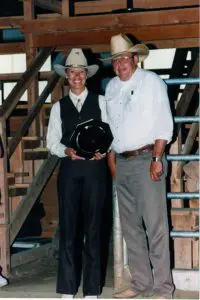 Everyone learned something at the Oregon Mr. Longears Mule Skinner Classic, including the judge! Dick and Debbie Cress and Alan and Elaine Case are to be heartily congratulated for their exceptional efforts in putting on a successful show and for taking wonderful care of this judge! Thank you to all of you who gave your time and efforts to work on the show and make it run as smoothly as it did! Thank you Larry and Fran Howe for coming with me from Colorado to help judge the packing classes and for helping to Ring Steward and to Gary Hodges for his fine photography! My deepest congratulations go to all the exhibitors for a superb effort. Keep up the good work! Thanks to our announcer Roger Harrison. And a very special congratulations to all of our Mule Skinner Classic Champions!
Everyone learned something at the Oregon Mr. Longears Mule Skinner Classic, including the judge! Dick and Debbie Cress and Alan and Elaine Case are to be heartily congratulated for their exceptional efforts in putting on a successful show and for taking wonderful care of this judge! Thank you to all of you who gave your time and efforts to work on the show and make it run as smoothly as it did! Thank you Larry and Fran Howe for coming with me from Colorado to help judge the packing classes and for helping to Ring Steward and to Gary Hodges for his fine photography! My deepest congratulations go to all the exhibitors for a superb effort. Keep up the good work! Thanks to our announcer Roger Harrison. And a very special congratulations to all of our Mule Skinner Classic Champions!
To learn more about Meredith Hodges and her comprehensive all-breed equine training program, visit LuckyThreeRanch.com, MEREDITH HODGES PUBLIC FIGURE Facebook page, or call 1-800-816-7566. Check out her children’s website at JasperTheMule.com. Also, find Meredith on Pinterest, Instagram, MeWe, YouTube and Twitter.
Covered in TRAINING MULES & DONKEY: A LOGICAL APPROACH TO TRAINING, TRAINING WITHOUT RESISTANCE, EQUUS REVISITED and A GUIDE TO RAISING & SHOWING MULES at www.luckythreeranchstore.com.
© 1990, 2016, 2024 Lucky Three Ranch, Inc. All Rights Reserved.

Here’s a humorous mule tale for all of you Longears Lovers to read from our friends in Switzerland. ENJOY!
Maurice Zermatten
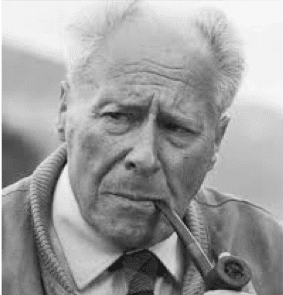 Pierre Bovier tied the rope around the iron bar that follows the wall; with the back of his hand he hit his mule on the back, as a sign of his friendship. He pulled a crackling piece of hay out of the oat sack, took his two cheeses under his arms and walked away. It was still winter up there, no relief was to be seen anywhere; dirty snow, half melted from the wind, covered the whole slope with a lifeless blanket. Perhaps the young grain’s stalks were already trembling beneath him. The grass sounded like the call of spring. The roots trembled in the frosty earth. Impatience ate the souls of the people. But the plain shone in the bright spring light. Pierre Bovier saw spring from his village Euseigne. Every day he watched for a long time the triangle of sap-laden earth between the sloping columns of the valley entrance. He would have loved to dig his working hands into the humid cold of the revived vines. He stretched his head, he looked and looked. Then he couldn’t stand it any longer. He could no longer stay in this house surrounded by death. He took his mule and he went away. So he went down to the valley and pulled his animal by the reins. The mule stretched his neck towards spring. Two small cheeses hung in the oat sack. He
Pierre Bovier tied the rope around the iron bar that follows the wall; with the back of his hand he hit his mule on the back, as a sign of his friendship. He pulled a crackling piece of hay out of the oat sack, took his two cheeses under his arms and walked away. It was still winter up there, no relief was to be seen anywhere; dirty snow, half melted from the wind, covered the whole slope with a lifeless blanket. Perhaps the young grain’s stalks were already trembling beneath him. The grass sounded like the call of spring. The roots trembled in the frosty earth. Impatience ate the souls of the people. But the plain shone in the bright spring light. Pierre Bovier saw spring from his village Euseigne. Every day he watched for a long time the triangle of sap-laden earth between the sloping columns of the valley entrance. He would have loved to dig his working hands into the humid cold of the revived vines. He stretched his head, he looked and looked. Then he couldn’t stand it any longer. He could no longer stay in this house surrounded by death. He took his mule and he went away. So he went down to the valley and pulled his animal by the reins. The mule stretched his neck towards spring. Two small cheeses hung in the oat sack. He 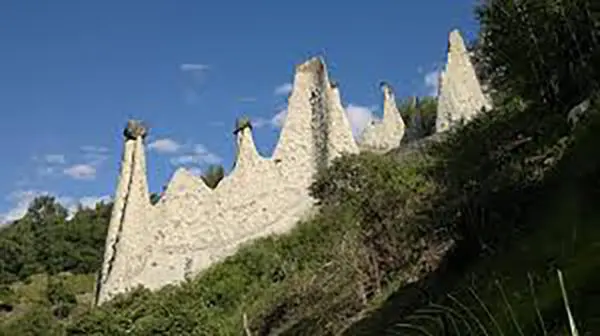 would sell this cheese, he would pay his debts to the bank. Two twenty-franc notes, a few glasses of wine to drink with one he meets in the bustling city before climbing back up to his village. This is our life. The reins are stretched, the mule hurries forward. Now Pierre Bovier is looking for a place in the city to put up his cheese. It is wonderfully warm. The sun makes its bright spots dance on the roadsides, the light stops on the groups of women, hangs on the yellow wicker baskets dangling from its arms. In the fishmonger’s display the sun delicately silvered the scales, sticking tinsel gold into the fur of the thick rabbits that are destined for the cooker. “What is the cheese?” “Twenty-five francs a piece.” The deal was closed, and Pierre Bovier walked straight to the bank, pulled out of his pocket a green, dirty envelope; paid. When he was back on the street he suddenly felt a strong thirst at the bottom of his throat and he decided, to satisfy it immediately.
would sell this cheese, he would pay his debts to the bank. Two twenty-franc notes, a few glasses of wine to drink with one he meets in the bustling city before climbing back up to his village. This is our life. The reins are stretched, the mule hurries forward. Now Pierre Bovier is looking for a place in the city to put up his cheese. It is wonderfully warm. The sun makes its bright spots dance on the roadsides, the light stops on the groups of women, hangs on the yellow wicker baskets dangling from its arms. In the fishmonger’s display the sun delicately silvered the scales, sticking tinsel gold into the fur of the thick rabbits that are destined for the cooker. “What is the cheese?” “Twenty-five francs a piece.” The deal was closed, and Pierre Bovier walked straight to the bank, pulled out of his pocket a green, dirty envelope; paid. When he was back on the street he suddenly felt a strong thirst at the bottom of his throat and he decided, to satisfy it immediately.
Drinking doesn’t always quench thirst. Pierre Bovier ordered three pints, then, still thirsty, another three. He liked it quite well in this pub full of clouds of smoke. He met a few friends here every time and the landlady could testify that they did not part before drinking friendship several times. But just today he didn’t know anybody. Maybe someone would come soon. There must have been a farmer at the next table, as lonely as he was. He did not look very social. At least you could try it. The misfortune wanted them to turn their backs. You had to wait for something, for something in common, to get close to each other. Outside the early February spring was still blowing through the streets. It was so beautiful, so light, so full of smiles, that it made you feel like brothers. One suffered from his loneliness. There he could not stand it any more. “What weather!” The other turned around and said, “Yes, one has never seen anything like it before.” That was enough. They closed their loneliness together, ordered half a liter. “Health!” “Health!” They soon realized that they were made to understand each other, because they had the same thirst and the same worries. Soon there was a certain familiarity between them. They talked about cattle prices, politics, and wine. They understood each other in all points: The cattle sold badly. The government ruled even worse. As far as wine was concerned, it was a shame. “Health!” “Health!” “With us in Ayent…” Ayent, but that was the village Pierre Bovier saw over the plain, just across from him on the other side of the river Rhone. Often he had wanted for his own village to have this spot in the sun, this early spring, while in his case. But he did not want to grieve. The afternoon passed in an instant, and the evening light was already sinking against the windows. The nights come early, in February. You hardly have time to sit down quickly and toast. The landlady turned the switch on. Again it was bright in the pub. The two friends were happy about it and ordered another half. “The conservatives …” said one. “The radicals …”, said the other. They mistook everything, by the way, put on the account of the radicals the political mistakes of the conservatives and accused the conservative leaders of clumsy words spoken by a leader of the radical party. What else did that do? They also mistook their glasses and would drink from one, then from the other glass.
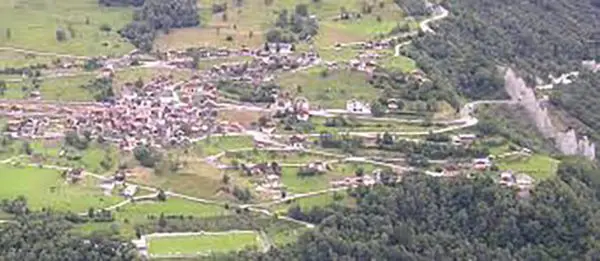 It struck eleven o’clock. The landlady refused them the last half liter. So they had no choice but to leave. They rose and were outraged at this heartless creature, that had placed them in front of the door, stumbled between the tables, swayed down the street in all its width, finally trusted the walls, and when the walls stopped, they supported each other’s disturbed balance. They would have liked to drink another glass, equalize the other glasses. But all the doors were closed. So they had to do without, for better or for worse, and they did it by scolding the bad times. They decided to return home, the one from Ayent to Ayent and Pierre Bovier to Euseigne. “Where do you have your mule?” “There he is, next to yours.” The mules waited in the cool night. Swaying, the fathers (lads) gave each other their hands and then loosened their animals. It was no small thing for them to get on the saddle. After all, Ayent’s succeeded first, after some unsuccessful attempts. And the mule rode off with the hasty step of a hungry animal. Euseigne, for his part, managed to climb the animal after many attempts and violations of the second commandment. A lucky fool shortened the way home. Almost at the same time, the two companions felt their animals stop. We have arrived, said the mule’s frozen gestures. “Where am I,” stammered the one from Ayent, for he no longer knew his barn. “But I am in Ayent,” the one from Euseigne suddenly sobered. After they had confused the radical doctrine with the conservative, then their glasses, they had now also confused their mules. But the mules had not been wrong in their way home.
It struck eleven o’clock. The landlady refused them the last half liter. So they had no choice but to leave. They rose and were outraged at this heartless creature, that had placed them in front of the door, stumbled between the tables, swayed down the street in all its width, finally trusted the walls, and when the walls stopped, they supported each other’s disturbed balance. They would have liked to drink another glass, equalize the other glasses. But all the doors were closed. So they had to do without, for better or for worse, and they did it by scolding the bad times. They decided to return home, the one from Ayent to Ayent and Pierre Bovier to Euseigne. “Where do you have your mule?” “There he is, next to yours.” The mules waited in the cool night. Swaying, the fathers (lads) gave each other their hands and then loosened their animals. It was no small thing for them to get on the saddle. After all, Ayent’s succeeded first, after some unsuccessful attempts. And the mule rode off with the hasty step of a hungry animal. Euseigne, for his part, managed to climb the animal after many attempts and violations of the second commandment. A lucky fool shortened the way home. Almost at the same time, the two companions felt their animals stop. We have arrived, said the mule’s frozen gestures. “Where am I,” stammered the one from Ayent, for he no longer knew his barn. “But I am in Ayent,” the one from Euseigne suddenly sobered. After they had confused the radical doctrine with the conservative, then their glasses, they had now also confused their mules. But the mules had not been wrong in their way home.
—-
From the magazine: Zürcher Illustrierte
Volume (year): 14 (1938), Issue 11
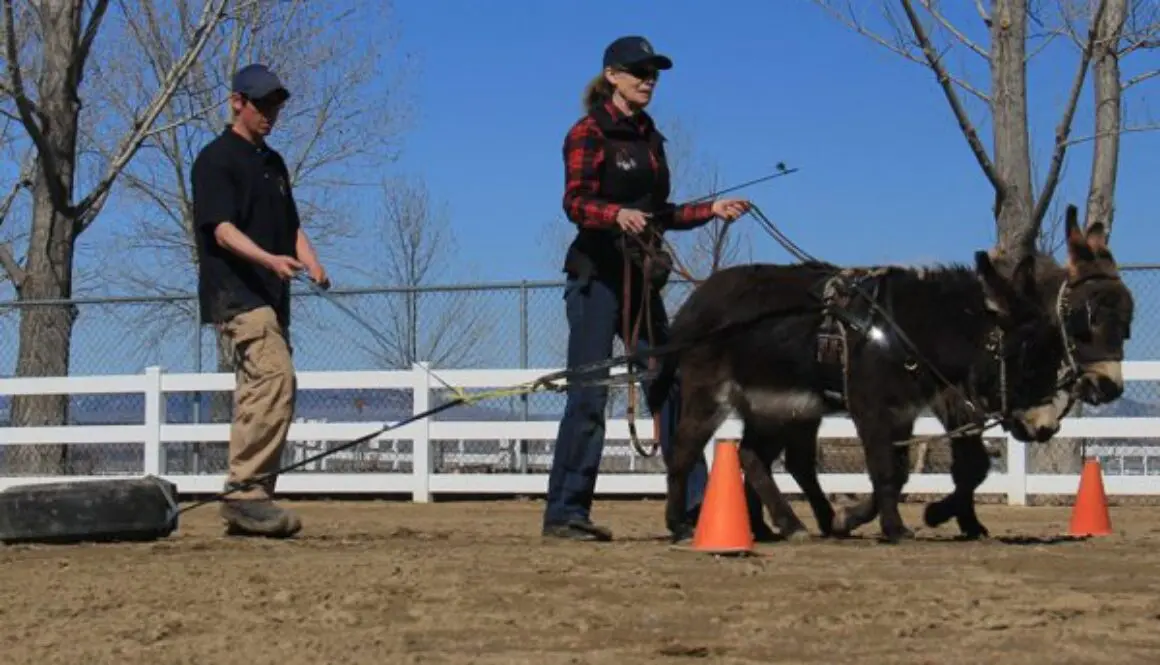


By Meredith Hodges
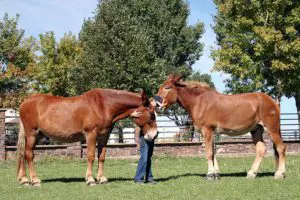 When I was growing up, my grandmother constantly reminded me of the importance of good manners. She would say, “You will never get anywhere of any consequence in this world without good manners!” And she would add, “Without good posture and proper dress, you won’t live long enough to enjoy it!” She made me read Emily Post’s Book of Etiquette from cover to cover. In retrospect, although reading the entire book was a real chore, the respect for good manners that she passed on to me has been an extremely valuable gem in my training experience with equines.
When I was growing up, my grandmother constantly reminded me of the importance of good manners. She would say, “You will never get anywhere of any consequence in this world without good manners!” And she would add, “Without good posture and proper dress, you won’t live long enough to enjoy it!” She made me read Emily Post’s Book of Etiquette from cover to cover. In retrospect, although reading the entire book was a real chore, the respect for good manners that she passed on to me has been an extremely valuable gem in my training experience with equines.
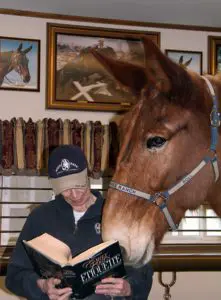 I think that the concept of combining equine training techniques with lessons in good manners is one that many people do not pay as much attention to these days as they probably should. Putting an equine in good posture with respect to his physical comfort is the most obvious form of good manners when communicating with your equine. When you apply the elements of good manners during the training process, you facilitate body and verbal language that equines really appreciate, and when you apply your own good manners and teach good manners to your equine from the very beginning of the training process, you can continue to move forward much more easily than if you do not incorporate good manners between you and your equine. When you run into resistance from your equine, take it as a red flag that you’re missing something in your communication with your animal and change your approach.
I think that the concept of combining equine training techniques with lessons in good manners is one that many people do not pay as much attention to these days as they probably should. Putting an equine in good posture with respect to his physical comfort is the most obvious form of good manners when communicating with your equine. When you apply the elements of good manners during the training process, you facilitate body and verbal language that equines really appreciate, and when you apply your own good manners and teach good manners to your equine from the very beginning of the training process, you can continue to move forward much more easily than if you do not incorporate good manners between you and your equine. When you run into resistance from your equine, take it as a red flag that you’re missing something in your communication with your animal and change your approach.
A common problem equine owners share is catching their equines. One of the elements of good manners that will help you in this task is being considerate toward your equine. When you are considerate about his need to have a routine that he can count on, he will quickly learn to look forward to seeing you at specific times during each day (at the very least, at feeding time in the morning and evening). His anticipation of your visit may appear to be only for the food value. However, when you interact with him at these times, what you say and do will lay the groundwork for your working relationship going forward, the next time you need to catch him, and during lessons. The food reward becomes less important to him over time.
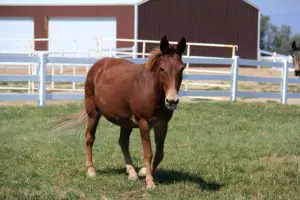 If your equine spends most of his time in the pasture, the good manners of promptness and reliability on your part are critical, as it is the only time you will have during the day to really spend time with him, and he’ll count on you to show up on time each day. What you’ll get out of being prompt at feeding times is a self-discipline that will carry over into everything that you do and will determine whether or not you are a reliable partner in the relationship with your equine. When you feed the oats mixture at night and none in the morning, it gives your equine a reason to come to you after breakfast when you offer oats to catch him, and gives him a reason to come back in off the pasture after being turned out for only a short time in the spring when pasture time needs to be limited. Doing something when it is convenient rather than considering the equine’s need for reliability in the trainer is a recipe for chaos and causes anxiety in both the equine and the trainer. However, having a predictable structure to your routine will allow both you and your equine to remain calm and clear in your communication with each other.
If your equine spends most of his time in the pasture, the good manners of promptness and reliability on your part are critical, as it is the only time you will have during the day to really spend time with him, and he’ll count on you to show up on time each day. What you’ll get out of being prompt at feeding times is a self-discipline that will carry over into everything that you do and will determine whether or not you are a reliable partner in the relationship with your equine. When you feed the oats mixture at night and none in the morning, it gives your equine a reason to come to you after breakfast when you offer oats to catch him, and gives him a reason to come back in off the pasture after being turned out for only a short time in the spring when pasture time needs to be limited. Doing something when it is convenient rather than considering the equine’s need for reliability in the trainer is a recipe for chaos and causes anxiety in both the equine and the trainer. However, having a predictable structure to your routine will allow both you and your equine to remain calm and clear in your communication with each other.
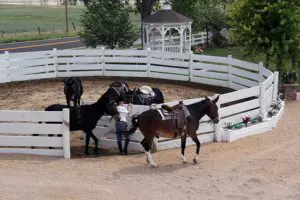 If you want your equine to come to you, rather than chasing him, simply stand at the gate or doorway and ask him to come to you, offering the oats reward when he does. If you are kind, patient and consistent, he will most likely always oblige you.
If you want your equine to come to you, rather than chasing him, simply stand at the gate or doorway and ask him to come to you, offering the oats reward when he does. If you are kind, patient and consistent, he will most likely always oblige you.
Put on the halter politely, being careful not to make any abrupt moves and always being protective of his ears. Before you exit the pen or stall, give him a reward of oats for standing still and waiting for you to finish putting on the halter. Then give him another mouthful, which will keep him busy so you can exit the pen before he does. This teaches him to always stop and wait for your invitation to exit any area. Now he is learning the good manners of allowing you to go through any gates first, and the chances of his becoming a bully will be greatly lessened. When you have multiple animals in a pen and want only one at a time through the gate, just be sure to reward 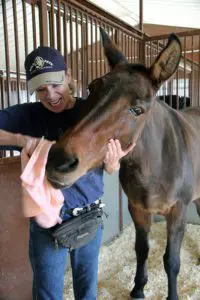 the others for standing back after you have rewarded the one you want for allowing you to halter him. This will also avoid anxiety in the one you are haltering, because he knows you will protect him and wave back the others who might otherwise crowd him or kick at him. The ones you wave back will learn that if they comply, a reward is coming.
the others for standing back after you have rewarded the one you want for allowing you to halter him. This will also avoid anxiety in the one you are haltering, because he knows you will protect him and wave back the others who might otherwise crowd him or kick at him. The ones you wave back will learn that if they comply, a reward is coming.
During grooming, be polite and considerate about how you touch your animal over every part of his body. Pay special attention to sensitive areas (which is a part of imprinting), how you use your grooming tools regarding pressure over bones and around sensitive areas, and how much disciplinary pressure can be applied if your equine becomes agitated and uncooperative. This is the way to sensitize him to communicate with his trainer. When you are polite and considerate, your animal will learn to trust you and be curious rather than afraid of what is going to happen next. If he paws and shows anxious behavior, ask him to stand still only when you are directly working on him, and then allow him expression of his anxiety in between times. If you pay attention to these negative behaviors, they will only escalate, but when you don’t react to the anxious behaviors he may show at times, the behaviors will eventually subside with age and maturity.
Don’t expect to be able to control your equine’s vocal expressions. Allow him his vocal expression and feel free to engage in the “discussion” he is initiating. Eventually, his vocal expressions will become predictable (upon your approach, answering your responses, at feeding time, etc.) because you acknowledge his polite vocal requests for attention.
 Being in good posture feels good to all of us and allows all the organs in the body to work correctly. When one is comfortable and amply prepared for physical activity, it is always more enjoyable. This is no different for equines. When you don’t consistently pay attention to your own good posture, neither will your equine pay attention to his. His movements will tend to be difficult and unpleasant, and the relationship between the two of you may begin to erode. But when your equine is encouraged to be in good posture during training, it feels good to him and, over time, will become his normal way of moving and resting. He will also be grateful for your kindness and consideration, and he will look forward to the activities he gets to do and the time he spends with you. When you pay attention to your own good posture right from the beginning of leading training and every time you work with your equine, he will be able to mirror your good posture. The result will be his own good posture, which will result in more comfort for him.
Being in good posture feels good to all of us and allows all the organs in the body to work correctly. When one is comfortable and amply prepared for physical activity, it is always more enjoyable. This is no different for equines. When you don’t consistently pay attention to your own good posture, neither will your equine pay attention to his. His movements will tend to be difficult and unpleasant, and the relationship between the two of you may begin to erode. But when your equine is encouraged to be in good posture during training, it feels good to him and, over time, will become his normal way of moving and resting. He will also be grateful for your kindness and consideration, and he will look forward to the activities he gets to do and the time he spends with you. When you pay attention to your own good posture right from the beginning of leading training and every time you work with your equine, he will be able to mirror your good posture. The result will be his own good posture, which will result in more comfort for him.
Being in good posture is not a natural thing for anyone—humans or equines—it must be consciously learned. So through self-discipline, you as the trainer, become the role model for the equine. When you work together like this, you both learn to be in good posture. However, if you are not in good posture, then it will adversely affect both of you, and your equine will be unable to find his own good posture, which will in turn, negatively affect his performance. In order for training to go forward smoothly from one step to the next, both you and your equine need to learn how to walk in good posture.
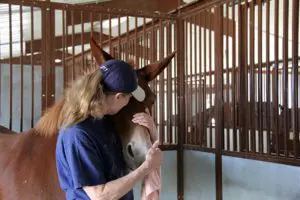 There will be times when it is necessary to employ negative reinforcement to stop bad behaviors that can escalate and become truly dangerous behaviors before they become persistent and uncontrollable. These corrections, which are covered in DVD #2 of my Training Mules and Donkeys series, are the equivalent of a firm and definite “No!” and help define the boundaries of your relationship with your equine. When boundaries are not clearly set, the result is disrespect from your animal, but when boundaries are clearly set and are consistently maintained right from the start, the incidence of bad behavior from your equine is greatly reduced.
There will be times when it is necessary to employ negative reinforcement to stop bad behaviors that can escalate and become truly dangerous behaviors before they become persistent and uncontrollable. These corrections, which are covered in DVD #2 of my Training Mules and Donkeys series, are the equivalent of a firm and definite “No!” and help define the boundaries of your relationship with your equine. When boundaries are not clearly set, the result is disrespect from your animal, but when boundaries are clearly set and are consistently maintained right from the start, the incidence of bad behavior from your equine is greatly reduced.
It is critical for your equine to break things down into very do-able steps for which he can be rewarded. For the best and safest results in this kind of equine training and management, it is vitally important that you use good manners yourself to teach your equine good manners, and employ both good manners and good posture throughout your entire relationship with your equine. If you always practice good manners when communicating with your equine, you might even get a “Head Hug!”
To learn more about Meredith Hodges and her comprehensive all-breed equine training program, visit LuckyThreeRanch.com, MEREDITH HODGES PUBLIC FIGURE Facebook page, or call 1-800-816-7566. Check out her children’s website at JasperTheMule.com. Also, find Meredith on Pinterest, Instagram, MeWe, YouTube and Twitter.
Covered in TRAINING MULES & DONKEY: A LOGICAL APPROACH TO TRAINING, TRAINING WITHOUT RESISTANCE, EQUUS REVISITED and A GUIDE TO RAISING & SHOWING MULES at www.luckythreeranchstore.com.
© 2013, 2015, 2016, 2024 Lucky Three Ranch, Inc. All Rights Reserved.

By Elke Stadler
The history of mankind is closely connected with the use of the working force of animals. Animal power was of special importance in transport and traffic – before motorization it was the only available movable driving force, almost at any time and versatile. What people themselves could not wear or pull; oxen, mules, horses and donkeys carried or pulled. In the past, despite their essential importance for working life and the economy, the working animals were hardly noticed in literature.
The work of the animals was so natural to the people of that time that it was not considered necessary to describe their characteristics or the circumstances of their use for people in more detail. Thus, in historical scriptures, animals appear even rarer than slaves and farmhands; they stand at the end of the hierarchy of values and remain mutely. But there is much to be learned from the late antique veterinary writings about their living conditions. The “Mulomedicina Chironis” – the most significant surviving ancient scripture about medical treatment of equids – was used until the Middle Ages and, as copies prove, further into the late Gothic period.
Cattle and Horse
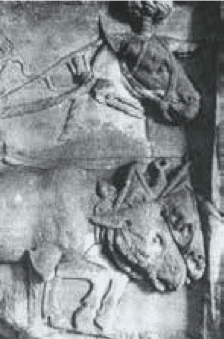 At that time, cattle were the most important draft animals, less for meat production, and milk was also of little importance. Cattle were mainly used in agricultural traction work or heavy transports with wagons. Oxen were indispensable for long-distance transport. No person, no matter how much they preferred mules, camels or even elephants, could do without cattle. They were much less demanding of food and care than the sensitive horse, which was expensive to keep. The mule took a special position because of its outstanding qualities. Horses are hardly mentioned in the old writings as draft animals for heavier loads. Mostly, they were used for light wagons. Horses were the mount of the high-ranking men, both civilian and military, and also served as a pack animal.
At that time, cattle were the most important draft animals, less for meat production, and milk was also of little importance. Cattle were mainly used in agricultural traction work or heavy transports with wagons. Oxen were indispensable for long-distance transport. No person, no matter how much they preferred mules, camels or even elephants, could do without cattle. They were much less demanding of food and care than the sensitive horse, which was expensive to keep. The mule took a special position because of its outstanding qualities. Horses are hardly mentioned in the old writings as draft animals for heavier loads. Mostly, they were used for light wagons. Horses were the mount of the high-ranking men, both civilian and military, and also served as a pack animal.
The most important limitation of the horse’s work in the draft service was technical difficulties. The shoulders of the horse protrude only very little, thus, the use of a shoulder yoke becomes impossible; the animal must pull with a neck harness, or a yoke sitting very high at the neck. In this way, the draft-horses and mules are represented also on Roman reliefs. Larger loads were not possible since they strangled the breathing of the animal with this tension. So, the animal could only use a small part of its body weight for pulling. The collar was unknown in Antiquity and late Antiquity, it was used for the first time in the Middle Ages.
Mule Breeding
In ancient times the mule played a special role in transport and traffic. On the road, it is the most popular draft animal due to its optimal characteristics. Although it is weaker than an ox, it is much faster than the ox. At the same time, a mule requires less food and care than a horse. It is also easier to use because of its general calmness. Thus, mule breeding yielded more profit than the usual breeding of medium-value horses. Their value was even compared to that of noble racehorses.
High quality mares were used for breeding at the age of four to ten years, and donkey stallions between three and ten years. We can read that the Arcadian or Reatic donkey stallions should be preferably black or spotted, but not of grey color. Onagers, Asian wild donkeys, were also used for mating. Particularly appreciated were donkey stallions descended from a donkey that had been mated by an Onager. The wild nature was then broken and the begotten animal possessed the tameness of the mother as well as the dexterity of the Onager. The one-year old foal was separated from its mother and kept on rocky, mountainous terrain, so that it got hard hooves as a condition for profitable use in transport.
Use of Female and Male Mules
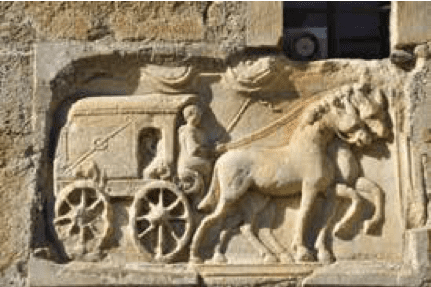 Female animals were used primarily for pulling wagons because of their agility, while male mules were used to carry loads. Various documents show this division for different purposes. Emperor Serverus Alexander gave his provincial leaders six female mules, two male mules and two horses. It is obvious that the female mules were intended for specific use as draft animals, the male mules as pack animals and the horses for mounts. The female mules were reserved for pulling which is evident from the fact that they were normally traded as a team. If one had a flaw, the seller had to take back both animals. It was especially popular when all the animals in front of a cart had the same color. The veterinarians gave recipes for dyeing the hair of the draft animals when it was not appropriate. To make white hair black, three ‘scripula’ (Roman unit of weight) cobbler’s blacks, four ‘scripula’ oleander’s juice and some goat fat are mixed, crushed and then applied. To make black hair white, a pound of wild cucumber root and twelve ‘scripula’ soda are crushed into powder, a cup of honey added, and then applied.
Female animals were used primarily for pulling wagons because of their agility, while male mules were used to carry loads. Various documents show this division for different purposes. Emperor Serverus Alexander gave his provincial leaders six female mules, two male mules and two horses. It is obvious that the female mules were intended for specific use as draft animals, the male mules as pack animals and the horses for mounts. The female mules were reserved for pulling which is evident from the fact that they were normally traded as a team. If one had a flaw, the seller had to take back both animals. It was especially popular when all the animals in front of a cart had the same color. The veterinarians gave recipes for dyeing the hair of the draft animals when it was not appropriate. To make white hair black, three ‘scripula’ (Roman unit of weight) cobbler’s blacks, four ‘scripula’ oleander’s juice and some goat fat are mixed, crushed and then applied. To make black hair white, a pound of wild cucumber root and twelve ‘scripula’ soda are crushed into powder, a cup of honey added, and then applied.
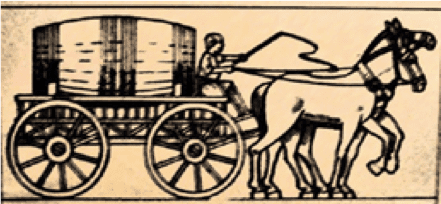 Most mules were not used as valuable draft animals in private passenger transport, but in public transport by rental car companies or by cargo. The provisions of Codex Theodosianus (late antiquity collection of laws) the ‘cursus publicus’, can give an approximate impression. Two car types are mentioned, the four-wheeled ‘raeda’ and the two-wheeled ‘birota’. The ‘raeda’ was fitted with eight mules in summer and ten in winter, 1000 pounds could be carried. When used by people, this corresponded to seven to eight passengers. For the ‘birota’ on the other hand, three mules and a maximum load of 200 pounds were prescribed, for a person’s use, this was two passengers.
Most mules were not used as valuable draft animals in private passenger transport, but in public transport by rental car companies or by cargo. The provisions of Codex Theodosianus (late antiquity collection of laws) the ‘cursus publicus’, can give an approximate impression. Two car types are mentioned, the four-wheeled ‘raeda’ and the two-wheeled ‘birota’. The ‘raeda’ was fitted with eight mules in summer and ten in winter, 1000 pounds could be carried. When used by people, this corresponded to seven to eight passengers. For the ‘birota’ on the other hand, three mules and a maximum load of 200 pounds were prescribed, for a person’s use, this was two passengers.
Adventure by Road
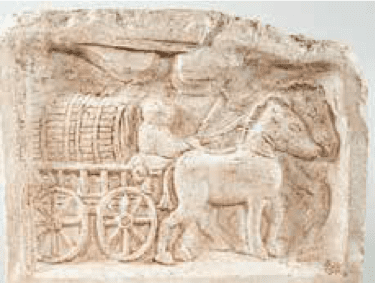 The journey with such public transport was accompanied by wild screams, whip cracks from a drunken coachman and clouds of dust, reports a letter writer named Eustathios: A trip with mules that were boisterous by doing nothing and feeding too much he avoided – and prefered to walk.
The journey with such public transport was accompanied by wild screams, whip cracks from a drunken coachman and clouds of dust, reports a letter writer named Eustathios: A trip with mules that were boisterous by doing nothing and feeding too much he avoided – and prefered to walk.
Cross-country journeys were quite risky, as Roman poet Vergil describes, especially because of the daring overtaking maneuvers of competing truck owners. But sometimes a driver had to go under the yoke himself when a mule had got stuck in the mud of the soaked and crushed road. During overtaking maneuvers on the narrow country roads there was damage to the gravestones on the roadside, as an inscription proves. This also shows that mules were used in long-distance traffic to Gaul. Emperor Julian tells about the dangers on narrow Alpine roads, to which both passengers and draft animals were exposed, so does a rock inscription for remembering a road construction from the year 373 A.D.
In the Jungle of Cities
In the mostly narrow cities, the mule-drawn heavy wagon traffic caused great difficulties. Since the early imperial period, carriage traffic and riding in the city during the first ten hours after sunrise were therefore forbidden. Trips in connection with construction measures were permitted, and these were already enough to endanger the lives of pedestrians on the roads with their big wagons and high stacked loads.
A case story, described by a lawyer, shows what could have happened. Two mule-drawn ‘plaustra’ (load carts) drive up the Capitol slope in Rome. The mule leaders of the first one are pressing against the ‘plaustrum’ so that the mules could pull easier. However, the first carriage begins to roll back anyway, and the mule drivers jump out between the carriages. The first team then rolls onto the second, which now also rolls down backwards and crushes into a boy. The lawyer blames the leader of the first carriage for this accident, as he would be responsible for the overloading of the first carriage. Such incidents were as other sources show not uncommon.
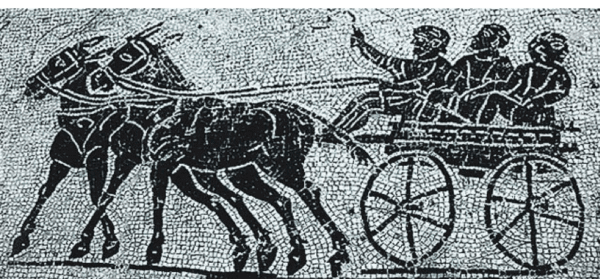
Medical Care
This hard use of mules in driving is reflected in the treatment instructions of late antique veterinarians. The neck injuries caused by the yoke, which Pelagonius expressly refers only to mules, are of special importance. It was recommended that in order to prevent neck injuries of mules or to heal after damage has occurred, was to use an ointment made from fresh pig fat boiled with vinegar. For injuries of the neck and back of the mules, a remedy made of boiled wax, hot resin, verdigris and oil is used. Another remedy for neck treatment is described in this way; rotting chips from the middle of a fig tree are to be dried and burned to ashes in a clean place. This is sieved and then mixed in a mortar with wine, old oil and the protein of two eggs. To make the neck supple – this is the prerequisite for clamping it in the yoke – the neck is thoroughly washed with soap and then rubbed with a carefully beaten mixture of rainwater and protein. Mules were considered less valuable than horses or assessed to be more tolerant of injuries – such as an injury that is indicated by a crossed gait and an insecure step, where the animal trips over stones and a contracted hip.
A horse should be treated carefully and immediately to prevent major damage. However, if the suffering animal is a mule, it should first be stretched tighter in the yoke, so that sweat and pain will smash all pain. After work, it should be treated with the following remedy; twenty laurels are finely crushed with soda and heated with a handful of green rue, vinegar and laurel oil. Then they rubbed this on the center of the head between the ears, they also took a remedy-soaked piece of wool and laid it on this area. Another agent is made from barley flour and resin. These treatments are accompanied by the application of a general strengthening agent made from crushed crayfish, goat’s milk and oil.
Pack Mules
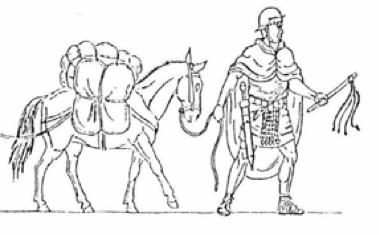 Male mules were used to carry less extensive loads in cities and agriculture because of their greater strength. The typical work was the transport of pole wood for plantations. Traders kept their mules directly in their shops. There is a case described in the Digests (scripts of ancient legal scholars) where a horse was led into a shop and was sniffing at the mule there. It kicked and broke the back of the horse’s leader. In the troop, each centurion had one such pack mule, which had to carry the heavier parts of the equipment on the marches.
Male mules were used to carry less extensive loads in cities and agriculture because of their greater strength. The typical work was the transport of pole wood for plantations. Traders kept their mules directly in their shops. There is a case described in the Digests (scripts of ancient legal scholars) where a horse was led into a shop and was sniffing at the mule there. It kicked and broke the back of the horse’s leader. In the troop, each centurion had one such pack mule, which had to carry the heavier parts of the equipment on the marches.
Drudgery in the mills
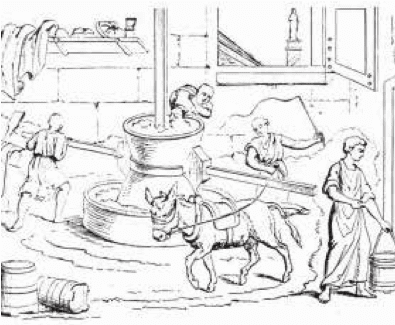 Mules were often used, as donkeys and horses were, to drive mills when they were no longer usable for other services. They were harnessed with a hard grass rope in front of the mill beam, the head was usually masked. They trotted in a furrow, always pushed by blows in the circle around. The bad condition of the animals corresponded to the gruelling work. In the “Methamorphoses”, Apuleius describes that the necks were swollen of wound rot, the nostrils were flaccid and dilated from coughing and dusty air. The body was disfigured by the constant blows and mange, the feet clumped by traveling permanently in a circle. These sufferings are also reflected in the veterinary writings, but the mill animals were certainly no longer treated.
Mules were often used, as donkeys and horses were, to drive mills when they were no longer usable for other services. They were harnessed with a hard grass rope in front of the mill beam, the head was usually masked. They trotted in a furrow, always pushed by blows in the circle around. The bad condition of the animals corresponded to the gruelling work. In the “Methamorphoses”, Apuleius describes that the necks were swollen of wound rot, the nostrils were flaccid and dilated from coughing and dusty air. The body was disfigured by the constant blows and mange, the feet clumped by traveling permanently in a circle. These sufferings are also reflected in the veterinary writings, but the mill animals were certainly no longer treated.
Mounts
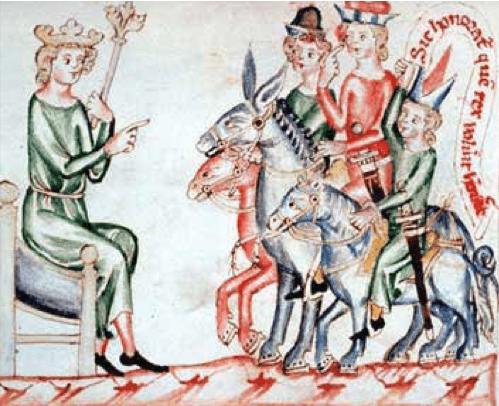 The mule was used rarely for riding in Antiquity, it was the simpler mount. Horace (poet) illustrates a simple but also free life in this way: He could bridle a mule at any time and head all the way to Taranto, even if the loins of the animal were rubbed sore by the heavy coat bag and the sides by the weight of the rider. The veterinarians list these specific injuries caused by riding, as well as, by loads being too heavy. The wounds are treated with ointments mixed from salt, wine, oil, raisin wine, pork fat and onions. In more severe cases, blood is taken from the veins of the groin area and mixed with salt, pork fat and oil. This is applied, and if necessary, plastered with ointment. For wounded skin caused by pressures, a dough-like mixture made of fine wheat flour, incense dust, egg yolk and vinegar is applied to the sore spots.
The mule was used rarely for riding in Antiquity, it was the simpler mount. Horace (poet) illustrates a simple but also free life in this way: He could bridle a mule at any time and head all the way to Taranto, even if the loins of the animal were rubbed sore by the heavy coat bag and the sides by the weight of the rider. The veterinarians list these specific injuries caused by riding, as well as, by loads being too heavy. The wounds are treated with ointments mixed from salt, wine, oil, raisin wine, pork fat and onions. In more severe cases, blood is taken from the veins of the groin area and mixed with salt, pork fat and oil. This is applied, and if necessary, plastered with ointment. For wounded skin caused by pressures, a dough-like mixture made of fine wheat flour, incense dust, egg yolk and vinegar is applied to the sore spots.
A special feature in those times were dwarf mules, called ‘mulae pumilae’, a curious luxury object of which the roman poet Martialis ironically states, that one often sits higher on the floor.
In the Middle Ages
 Although mules were regarded by the church leaders as originating from an unnatural connection, and thus had a bad reputation, the mule nevertheless experienced a great appreciation in the early Middle Ages. Since Spanish mules are a noble gift, Emperor Charlemagne sent them to Caliph Harun Rashid. Mules and their Saracen guardians were bestowed by Robert Guiscard (Norman leader) to the Abbot of Montecassino. The mule is often mentioned as a mount of clergy. Gallus, for example, uses a mule for his journey to the Swabian ducal court. Also, for the journey of Goar (Priest, later holy spoken) to the royal court, a mule or a donkey is intended. Bishop Gregory of Tours, mentions mules among the farm animals of the monastery St. Martin, which were obviously riding animals. Because of the clergy’s preference for mules, the devil – as Notker (poet and scholar) tells us he turns into a mule to tempt the bishop to buy him, seduces him and kills him on the way out. A degree accordingly acts against the excessive dealing of clergy with mules. Of course, mules were often used as pack animals in the early Middle Ages, just like horses. Already Isidor from Sevilla (Archbishop) speaks about the ‘mulus sagmaria’ (Latin: pack mule) beside the ‘caballus sagmarius’ (packhorse). Some of the mules and horses with which the Irish bishop Marcus returned from his trip to Rome must have been pack animals as books, gold objects and robes are mentioned as transported goods. In the Vita Hludovici (anonymous biography of Louis the Pious) mules are also mentioned beside horses, working a mission as they transported ship parts through the woods. Mules are also considered a pack animal in custom regulations.
Although mules were regarded by the church leaders as originating from an unnatural connection, and thus had a bad reputation, the mule nevertheless experienced a great appreciation in the early Middle Ages. Since Spanish mules are a noble gift, Emperor Charlemagne sent them to Caliph Harun Rashid. Mules and their Saracen guardians were bestowed by Robert Guiscard (Norman leader) to the Abbot of Montecassino. The mule is often mentioned as a mount of clergy. Gallus, for example, uses a mule for his journey to the Swabian ducal court. Also, for the journey of Goar (Priest, later holy spoken) to the royal court, a mule or a donkey is intended. Bishop Gregory of Tours, mentions mules among the farm animals of the monastery St. Martin, which were obviously riding animals. Because of the clergy’s preference for mules, the devil – as Notker (poet and scholar) tells us he turns into a mule to tempt the bishop to buy him, seduces him and kills him on the way out. A degree accordingly acts against the excessive dealing of clergy with mules. Of course, mules were often used as pack animals in the early Middle Ages, just like horses. Already Isidor from Sevilla (Archbishop) speaks about the ‘mulus sagmaria’ (Latin: pack mule) beside the ‘caballus sagmarius’ (packhorse). Some of the mules and horses with which the Irish bishop Marcus returned from his trip to Rome must have been pack animals as books, gold objects and robes are mentioned as transported goods. In the Vita Hludovici (anonymous biography of Louis the Pious) mules are also mentioned beside horses, working a mission as they transported ship parts through the woods. Mules are also considered a pack animal in custom regulations.
The existence of humans and the development of all processes, political and social, were marked by the importance of the working animals, not only in Antiquity and the Middle Ages, but also far into modern times. In the beginning it was mainly cattle that carried the workload. Over time there were shifts, the cattle were substantially relieved first in later Antiquity by the mule. Finally, in the Middle Ages the horse, caused by changes in animal technology – horseshoe fittings and collar – became more universally applicable. However, the donkey’s services remained to limited use.
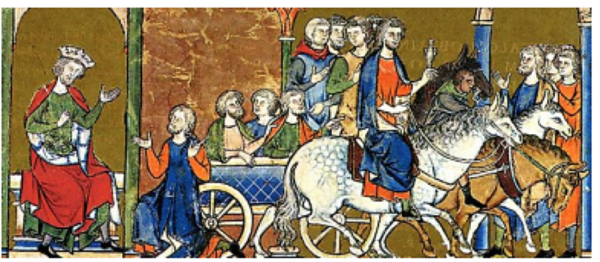
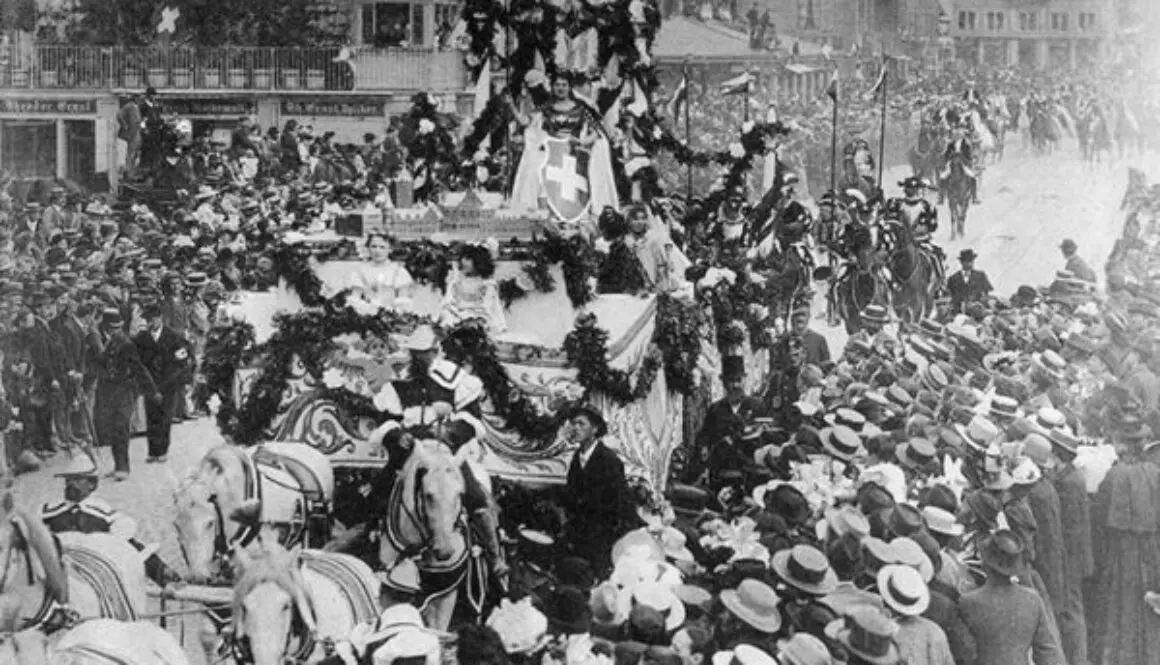
Please enjoy this historical post about their Longears from our friends in Switzerland!
By Josefine Jacksch
This year (2018) the Landesmuseum (Museum of the Country) in Zurich will be 120 years old. It is the most visited historical museum in Switzerland. Since January 2011 it has been part of the Swiss National Museum. Due to an increasing lack of space, it was extended from 2013 to 2016 with a modern extension that offers space for exhibitions, a library and a lecture hall.

A “central collection of art objects” was thought of as early as 1799, but the idea failed because of resistance from the cantons, which wanted to maintain their own historical collections. In 1890, however, the Landesmuseum was founded by law and then built as a castle-like building by Gustav Gull next to Zurich’s main railway station.
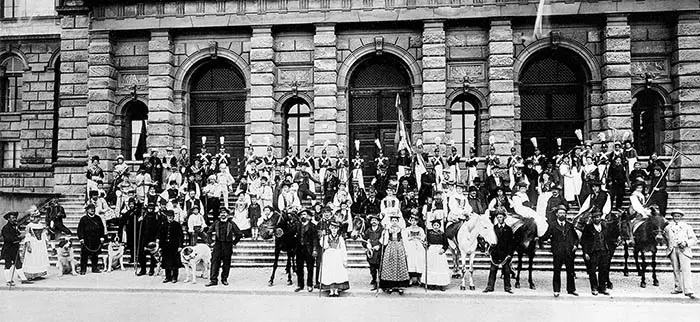
On 25 June 1898, the opening ceremonies took place, including a large parade. In 20 pictures the Swiss cantons passed by with 70 richly decorated carriages, 200 riders, groups in traditional costumes and various animals. The procession was led by a “magnificent carriage with Helvetia*”, followed by a carriage with “Turica, the protector of art”. In the group of the Canton of Valais, besides horses and Saint Bernard dogs, mules also passed by.
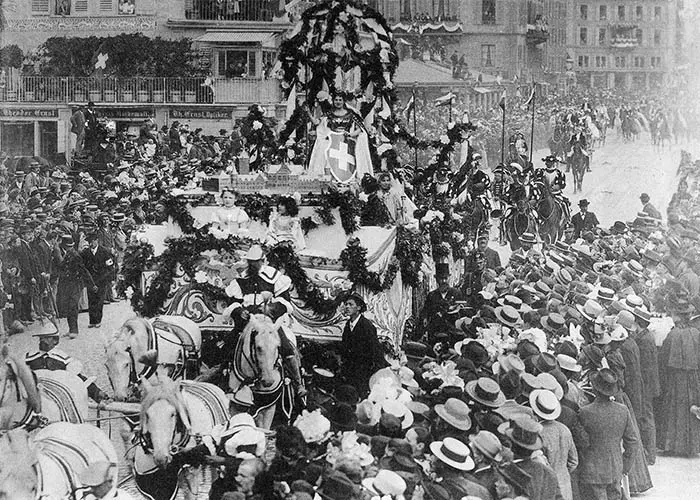
“It’s as if the parade of the traditional costume doesn’t want to end and the impression of the pictures is still increasing. The Valais is a true gem of a group, it shows a military picture, the festive parade in the Lötschen Valley, in addition come the women from Savièse village with her strangely (gorgeous/special) beautiful type, the gentle women from the Evolène Valley with their white delicate lace bonnets under the flat hat, the women from the Illiez Valley, who wear a dark man’s costume on Sundays, the monks of St. Bernard with their dogs and wandering people, which are today in the Rhône Valley in the vineyards, tomorrow on the mountain pasture. How the lovely little one laughs, strapped to a mule in his cradle, on which the mother rides. And everything is so wonderfully real, the pictures are talking books, the enormous originality and diversity of Swiss folk life, and the people of Valais are in first place, the strange people, where cheerfulness and deep seriousness merge into the most surprising nüances.”
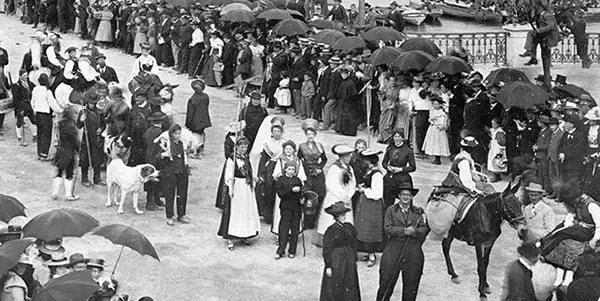
Sources:
https://blog.nationalmuseum.ch/en/2018/06/the-national-museums-opening-parade-in-1898/https://de.wikipedia.org/wiki/Landesmuseum_Zurich
* Helvetia is the female national personification of Switzerland, officially Confœderatio Helvetica, the Swiss Confederation.

By Meredith Hodges
To wear the breeches, or not to wear the breeches—that is the question. The Western training influence has been prevalent in our mule industry growth here in the United States, while other countries seem to vary with respect to their historical growth. Countries with an older equine history seem to prefer the English style of training, while newer frontiers have adopted the Western style of training out of necessity. The Western classes in breed shows reflect the varied uses of mules and horses which evolved as this country developed, and the bridles and saddles used were built out of practicality and need in a rough country atmosphere.
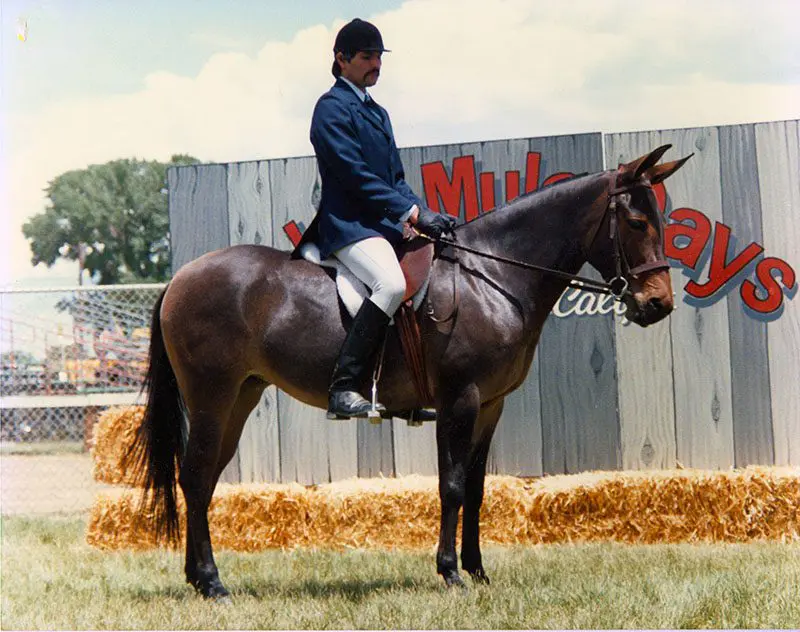 Today, we have more time to spend training our equines and cultivating our own riding skills. In most cases, the choice of tack is no longer of necessity, but of choice. Fashion, in any country, is supposed to be a statement of individuality and identity. The Western style of dress and tack suggests a hearty, rugged individual, surrounded by wide open spaces, using his equine as a partner for work. English attire paints a picture of dignity, reserve and concentrated skill. The Western image is a wonderfully romantic and picturesque way of seeing oneself, but it really doesn’t allow us the opportunity to improve our equestrian skills to the maximum. Western style riding is as limited as its uses. The smaller English saddle, made with a lot less leather, allows us to feel our equine’s body more closely (with the added stability of the stirrups) while we learn and exercise our bodies to become more harmonious with our mounts. As we can feel our equine more closely, so can he feel better the cues that we to give him. Thus, he can respond more accurately to our commands. However, most men don’t feel comfortable wearing “Sissy Pants” and riding in a “Sissy Saddle”—it just isn’t macho!
Today, we have more time to spend training our equines and cultivating our own riding skills. In most cases, the choice of tack is no longer of necessity, but of choice. Fashion, in any country, is supposed to be a statement of individuality and identity. The Western style of dress and tack suggests a hearty, rugged individual, surrounded by wide open spaces, using his equine as a partner for work. English attire paints a picture of dignity, reserve and concentrated skill. The Western image is a wonderfully romantic and picturesque way of seeing oneself, but it really doesn’t allow us the opportunity to improve our equestrian skills to the maximum. Western style riding is as limited as its uses. The smaller English saddle, made with a lot less leather, allows us to feel our equine’s body more closely (with the added stability of the stirrups) while we learn and exercise our bodies to become more harmonious with our mounts. As we can feel our equine more closely, so can he feel better the cues that we to give him. Thus, he can respond more accurately to our commands. However, most men don’t feel comfortable wearing “Sissy Pants” and riding in a “Sissy Saddle”—it just isn’t macho!
As most of you already know, Sally McLean and I got mules accepted by the United States Dressage Federation in 1986. It was a great day for mules, but it was also, almost my husband’s undoing! After a year of training our mules under English saddle in Dressage, we found them to be a lot more responsive and easier to train than they had been in the past. In addition, they were conditioned to perform well in both English and Western classes which only enhanced their versatility. With this obvious success, we decided to train exclusively under English tack. My husband, Gary admitted to this success, but let me know, in no uncertain terms, that he preferred to ride Western and that was all that he wanted to do! After all, everybody has their own preference. My only question was, had he given English a fair enough try before making his decision of preference? Since he had never ridden English, the answer was obvious. My daughter, Dena and I felt that he should at least give it a try!
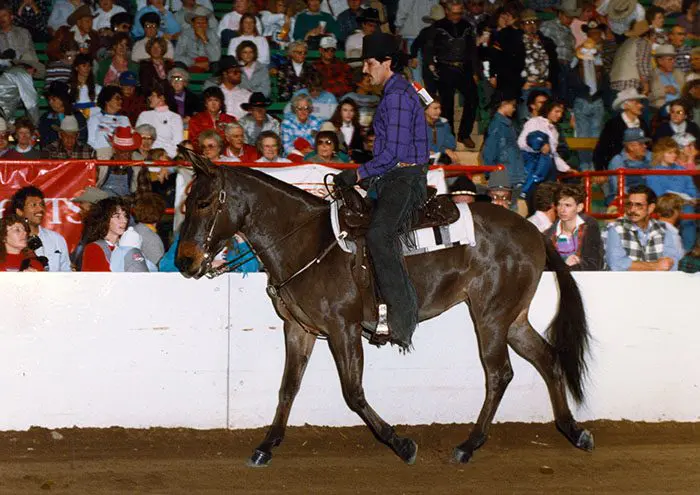 One Saturday morning, I finished a lesson with one of my students when Gary strolled into the indoor arena and announced that he was willing to give the English saddle a try, but that we would never get him into a pair of those “Sissy Pants!” “Fair enough,” I said, and brought my student’s horse around for him to ride. Getting on was a bit of a struggle, and exercises at the walk went really well, but as soon as the horse began to trot, Gary started bouncing. He was about to lose his balance, so he grabbed the rail to steady himself. The only problem was the rail stayed where it was and the horse kept going, leaving Gary dangling behind on the fence! I thought we would never stop laughing – he looked so ridiculous! Our macho man didn’t have the balance he thought he had!
One Saturday morning, I finished a lesson with one of my students when Gary strolled into the indoor arena and announced that he was willing to give the English saddle a try, but that we would never get him into a pair of those “Sissy Pants!” “Fair enough,” I said, and brought my student’s horse around for him to ride. Getting on was a bit of a struggle, and exercises at the walk went really well, but as soon as the horse began to trot, Gary started bouncing. He was about to lose his balance, so he grabbed the rail to steady himself. The only problem was the rail stayed where it was and the horse kept going, leaving Gary dangling behind on the fence! I thought we would never stop laughing – he looked so ridiculous! Our macho man didn’t have the balance he thought he had!
Gary decided not to give up on the first try and took English lessons at our clinics for the next few months, but continued to train his feisty half-Arabian mule, Lucky Three Cyclone, with the Western saddle. About 10 shows and 35 runaways later, he thought his balance to be good enough to try Cyclone under English tack. Within a couple of months, Cyclone was actually going where Gary wanted most of the time. This was an exciting breakthrough for Gary since Cyclone was the first mule Gary had ever trained by himself. Originally, he had wanted to train him for Western Pleasure and Reining, but he couldn’t get Cyclone to complete a circle without dodging or running off. Mules were supposed to be fun, but this was rapidly becoming an unpleasant chore. Gary asked me what he could do to make the training sessions with Cyclone more fun and rewarding. I suggested that he start with some elementary cavalletti and jumping exercises to add more variety to their routine. A couple of sessions later, they were a different pair. Cyclone became much more manageable and actually seemed to enjoy his sessions. Gary, too… except… after every session he got this weird look on his face… sort of pained, yet happy. When I asked what the problem was, he said English riding was great and Cyclone was improving rapidly, but it made him very sore!
On Gary’s birthday, two weeks before his first English classes at the Colorado Classic in 1988, I decided to take him to the tack store to be outfitted in proper English attire. I didn’t tell him where we were going because I knew how he would react. I just told him we were going to get his present. When we pulled into the tack store he said, “Is this the only place we’re going for my birthday?” So as not to alarm him too much, I told him we would go to the computer store afterwards.
After 45 minutes of coaxing from the dressing room to see how the pants fit, 25 minutes of explanations about why they needed to be tight and another 15 minutes of getting him out of a pair of English boots that were too small, Gary looked the picture of the English equestrian: tall, dark and very handsome in his new sporty attire! And in the next two weeks, he discovered the intrinsic value of his “Sissy pants”—you don’t get sore when you ride! Granted, you may have to take a little flack from a few ignorant cowboys, but the equestrian skills gained and the fun that goes with it far outweighs any adversity.
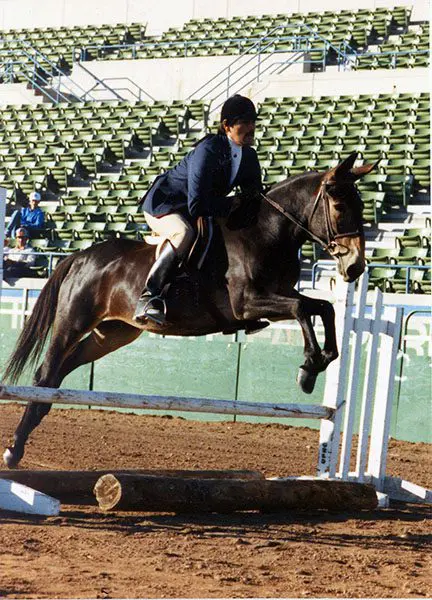 After a while Gary decided that English riding was, in fact, the best way to train. However, he still wasn’t too interested in “watching cement set” or doing Dressage tests. We decided after two years to start showing in Combined Training with the horses. We signed up for the second day of a two-phase show, not realizing that we would be asked to ride our Dressage tests the same day that we jumped. Two days before the show, Gary discovered that he would have to ride Training Level Test 1 at 9:00 A.M. the day of the show. We reviewed the test the day before the show, thinking that if all else failed I could read the test to him when he rode. Sunday morning, Gary was feeling tired, but confident. I took my place at “B” and prepared to read for him when the announcer explained that only United States Dressage Federation tests could have a reader, but not the same in Combined Training. Gary’s face turned ashen. I climbed back into the stands as he warmed up for his test… at the walk… lost in space! He stopped short below me and quietly said, “Meredith, will you please come here.” I ran down to see what the trouble was. “I can’t remember anything… I can’t do this!” he worried emphatically. I quickly explained the pattern. Gary’s first Dressage test ever in his first Combined Training show and he emerged in third place with a mule in the Elementary Division against 8 horses. Was he ever thrilled!
After a while Gary decided that English riding was, in fact, the best way to train. However, he still wasn’t too interested in “watching cement set” or doing Dressage tests. We decided after two years to start showing in Combined Training with the horses. We signed up for the second day of a two-phase show, not realizing that we would be asked to ride our Dressage tests the same day that we jumped. Two days before the show, Gary discovered that he would have to ride Training Level Test 1 at 9:00 A.M. the day of the show. We reviewed the test the day before the show, thinking that if all else failed I could read the test to him when he rode. Sunday morning, Gary was feeling tired, but confident. I took my place at “B” and prepared to read for him when the announcer explained that only United States Dressage Federation tests could have a reader, but not the same in Combined Training. Gary’s face turned ashen. I climbed back into the stands as he warmed up for his test… at the walk… lost in space! He stopped short below me and quietly said, “Meredith, will you please come here.” I ran down to see what the trouble was. “I can’t remember anything… I can’t do this!” he worried emphatically. I quickly explained the pattern. Gary’s first Dressage test ever in his first Combined Training show and he emerged in third place with a mule in the Elementary Division against 8 horses. Was he ever thrilled!
As my husband gazed into the adoring eyes of his numerous fans, I doubt that he felt less than “On Top of the World!” in his controversial “Sissy Pants.” A flood of compliments on his animal, his equitation and his turnout fell upon his ears, making him swell with pride and self-satisfaction. With a wink of his eye, Gary turned his mule around and walked proudly back to the trailer after the show, feeling very much a tall, dark and handsome macho man!
To learn more about Meredith Hodges and her comprehensive all-breed equine training program, visit LuckyThreeRanch.com, MEREDITH HODGES PUBLIC FIGURE Facebook page, or call 1-800-816-7566. Check out her children’s website at JasperTheMule.com. Also, find Meredith on Pinterest, Instagram, MeWe, YouTube and Twitter.
Covered in TRAINING MULES & DONKEY: A LOGICAL APPROACH TO TRAINING, TRAINING WITHOUT RESISTANCE, EQUUS REVISITED and A GUIDE TO RAISING & SHOWING MULES at www.luckythreeranchstore.com.
© 1990, 2016, 2024 Lucky Three Ranch, Inc. All Rights Reserved.

Please enjoy this article from our friend, Josefine at the SWISS BULLETIN. Mules have made their mark helping people with their tasks all around the world and their stories are nothing short of amazing! Loving Longears is something special that we all have in common despite our different languages. Read it, below:
By Alban Lorenz
The Valais lies in the southwest of Switzerland and is our little California. This canton is known for much sun, little rain, high mountains, good wine, sweet fruits and many tourisms. The main valley with the river Rhône, which flows into the Mediterranean, has many side valleys. A great number of mountain villages there were still without roads until the middle of the 20th century. The inhabitants had to transport everything by their own or they used pack animals (oxen or mules). Therefore, the Valais was the region in Switzerland that had the most mules until the 1960s.
Me, Alban Lorenz (*1939) and my brother Elias (*1932) grew up in Törbel, a mountain village high above the Matter Valley. At this time there were still 40 mules living in Törbel, before motorization also arrived there in the middle of the 20th century. The last mule in Törbel, Apollo, died in spring 2010, shortly before his master Bruno Hosennen. Bruno’s girlfriend, the artist Helen Güdel, has illustrated and published a children’s book about Apollo and Bruno.
After my apprenticeship, I moved to Zurich, Switzerland’s largest city, where I worked for the police until my retirement. Elias remained in his homeland and worked as a packer for many years. My family had his own mule. Some poorer families had to share a mule.
During the summer season some mules from Törbel were employed for transports up to mountain huts and hotels. The Hotel Belvedere in Zermatt is located high above the village at the foot of the Matterhorn, Switzerland’s most famous mountain. From the very beginning, all material, drinks and food for the hotel had to been transported up there by mules. The stable for the animals was near Lake Black (Schwarzsee), right next to the cable car station, that led up from the village Zermatt.So the mules could be packed right next to the station and led up to the hotel.
Goods had to be transported every day in all weathers, and the climb took three hours. The track was well worked out and led through steep rocky terrain to the hotel.Thewaste and empties of the hotel had to be transported on the same route back to the cable car station.
Mid 50s, early 60s, Elias worked some summers there as a packer with two mules on contract for the municipality of Zermatt. The mules he worked with were his own and a rented one. I had to replace him once for two days in the summer of 1963 and was able to make my own experiences.
There were times when Elias managed the transports only with his mule Belli. So it happened that one autumn day an early onset of winter arrived. The snowfall was so heavy that a walk back to Zermatt with the mule was impossible. However, the cable car could still run. This made it possible to load the mule into the cabin and drive Belli and Elias down to Zermatt, where the cable cabin and its contents arrived without any damage.
With Belli, Elias was also active as a packer for various other transports. When the Dom Hut of the Swiss Alpine Club was constructed high above the village Randa, mules were also used. During the construction of the earlier Monte Rosa Hut, the building material had to be transported by mules from the Gornergratrailway station over the glacier to the construction site. Belli had no trouble crossing the ice.
In Saas Grund was a transport company that often received larger transport orders. Therefore, the boss had to rent additional mules with their packers in addition to his own animals. Elias and his Belli were also mostly involved.
Unfortunately, Elias couldn’t avoid unpleasant transports. Among those were dead people who were fatally injured on the mountain. Once he had to bring down the body of his best friend on a mule, who had worked as a hut keeper in the Hörnli Hut.
One autumn day I was at home in Törbel, when my brother came home from Zermatt with the mules after a long time. By chance, I looked out the window of my parents’ house and saw Belli coming up the path. When the mule saw the house, she brayed loudly and ran the last part of the way to her place in front of the stable. This observation showed me that even a mule can be happy to finally come home after a long absence.
Photos of the Lorenz Family
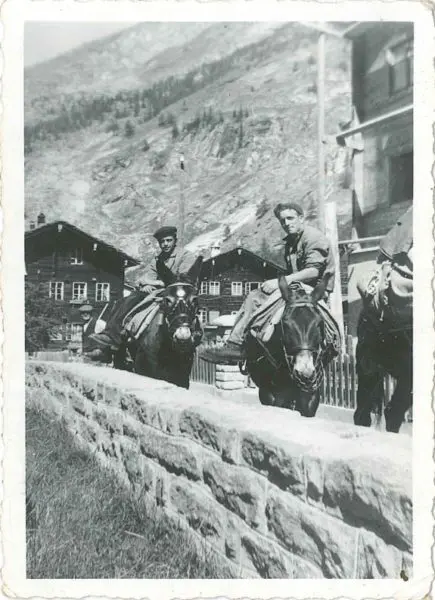
In Saas Grund, in the background packer Edelbert Juon
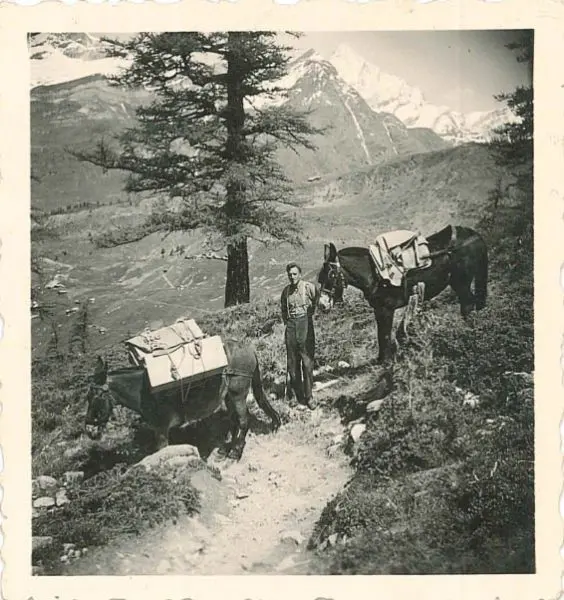
Elias Lorenz with two mules on the way to the Hotel Belvedere
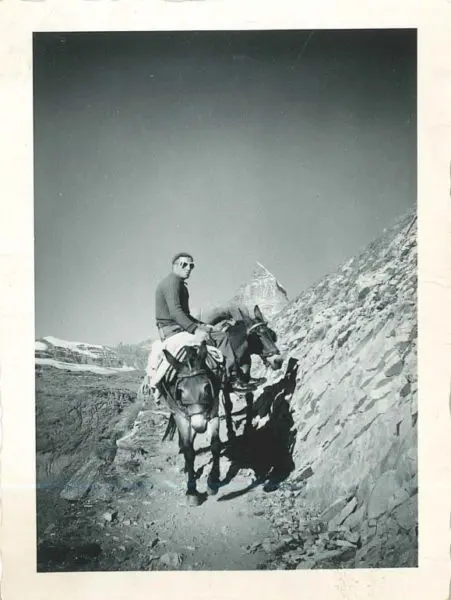
Elias Lorenz with 2 mules on the descent from Hotel Belvedere
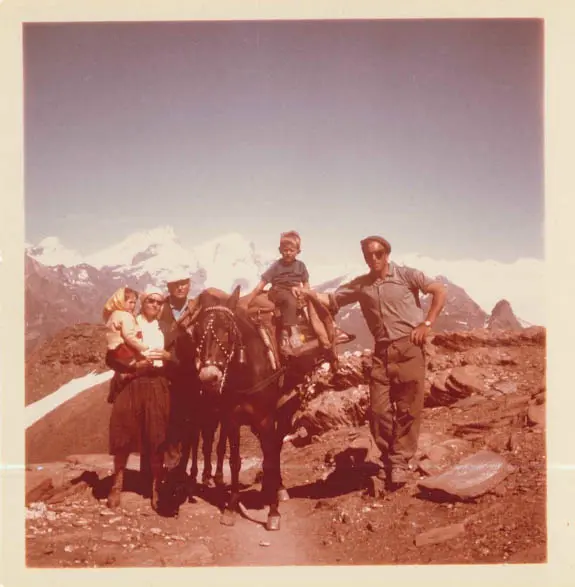
Mule Belli with tourists in Zermatt
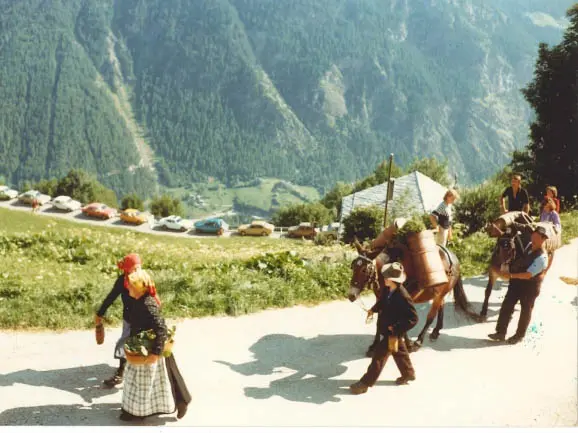
Parade in Törbel during a village festival in the 70s
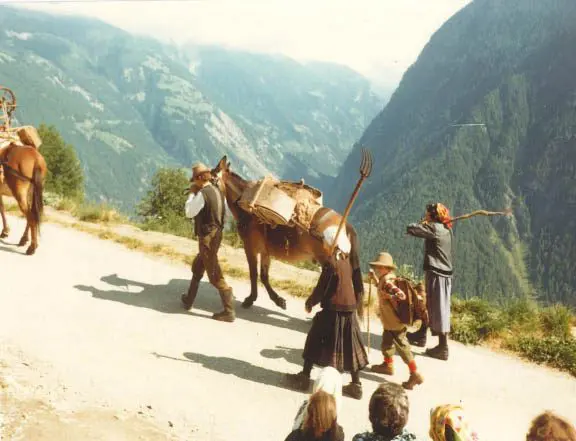
Parade in Törbel during a village festival in the 70s
Additional photos from the internet
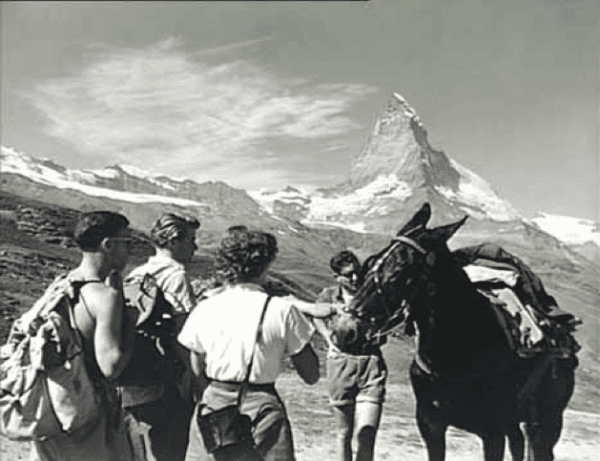
Riffelberg walk and view on the Matterhorn ca.1950
Photo: Fernand Perret, www.mediatheque.ch
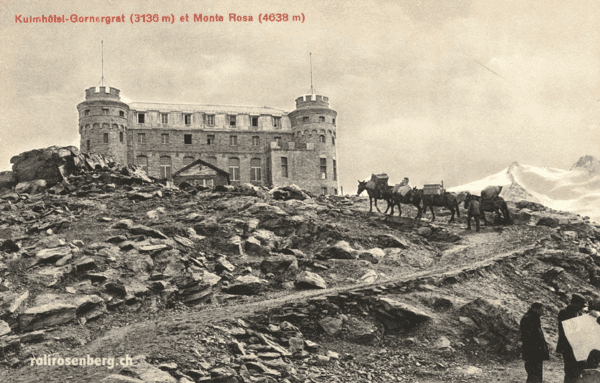
Hotel Gornergrat with packmules
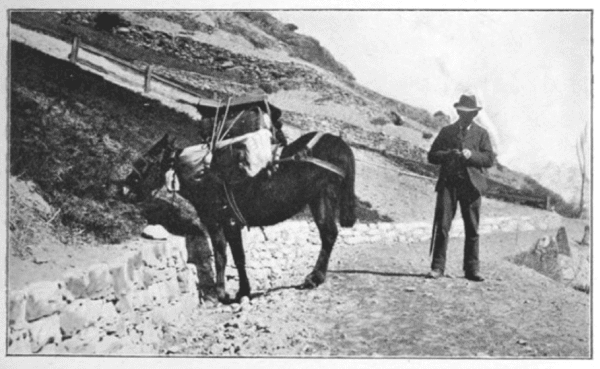
Going leisurely to Zermatt with a Mule for the luggage in the olden days.
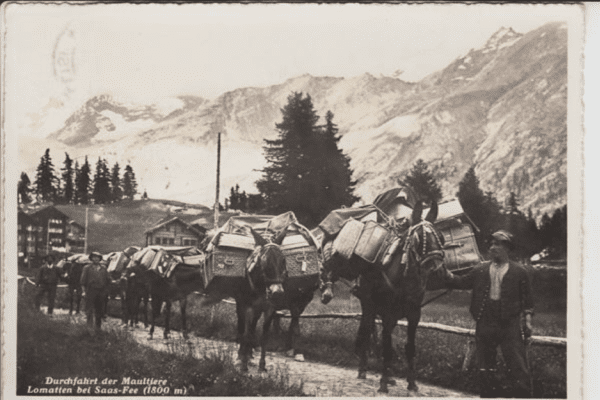
Passage of the mules, Lomatten near Saas-Fee (1800m) 1972. The man in front, Christian Lorenz, is the father of Alban and Elias. He worked also as packer.
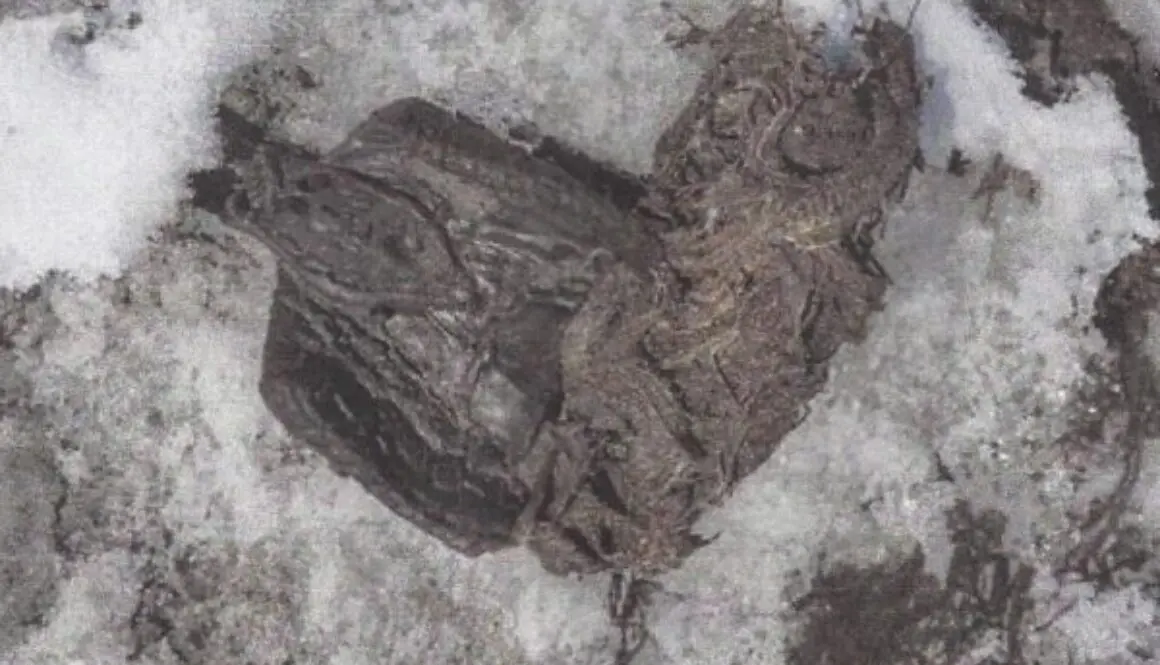
This article is written by Elke Stadler and from my friend, Josefine, editor of the Swiss Mule Bulletin in Switzerland! Since we share a love for Longears, we like to share each other’s respective mule historical experiences with our friends and fans. I hope you enjoy this article as much as I did! Thank you so much, Josefine! In the future, we look forward to more news from Switzerland in support of Longears:
The Theodul Pass
The name is derived from St. Theodul, the first known Valais bishop from the 4th century Walser German, it is called Theodul Yoke. From the 16th to the end of the 18th century it was called Augst Valley Pass (Augst = Aosta, Latin Augusta Praetoria), later, until the beginning of the 19th century, simply also called Valais Pass, then Matter Yoke. The special feature of the glaciated pass is its great height: 3,295 m above sea level (as of 2009). It is located in the Valais between the Matterhorn and the Breithorn. The pass, which crosses the border between Italy and Switzerland, connects Zermatt in the Matter Valley with Breuil-Cervinia in Valtournenche.
No other Alpine pass of comparable importance is higher than 2,900 m above sea level. The Theodul Pass has always been an important crossing point in the Valais Alps. A stone axe found in 1895 comes from Brittany and dates back to the Neolithic period (4000 to 3500 BC). It suggests that the pass was already in use at that time. Near the top of the pass, a Roman coin treasure dating from the 1st to 4th century AD was found. You can see it today at the Alpine Museum in Zermatt.
The Mule and the Theodul Pass
The Theodul Pass was probably commemorated with mules from the Roman period, possibly as early as the end of the late Iron Age. The oldest evidence for the use of mules in the Theodul Pass region can be found in late-medieval text sources that report on trade relations between the Matter Valley and the Aosta Valley. The “horses” repeatedly mentioned in this article can only be mules. From the early 20th century onwards, the use of the mule for the transport of goods over the Theodul Pass, represented only a rarity in view of increasingly difficult climatic conditions and the emergence of a modern transport network.
Dangerous conditions at the glacier pass
The historic pass consists of two sections: From Zermatt to the edge of the glacier a path on the grown soil; from there to the pass, as a rule, a track across the glacier. As a glacier pass, the transition to those altitudes in which passability is highly dependent on climatic conditions is sufficient. Daily fluctuations (hard snow, soft snow), seasonal influences (summer, winter, avalanches) as well as climatic changes over the centuries have an impact here.
The crossing of such a high pass was not safe for humans and animals. In the oral tradition of the Matter Valley there are numerous stories and legends that tell of mishaps of traders or farmers accompanied by their mule. In Zeneggen, for example, it is said that a farmer who went out with two mules to get wine in Italy got caught in a storm. The mules, who are known for keeping calm in all situations, came back to the village on their own and vice versa, while the owner, who was believed dead, followed a few days later.
Mule bone finds and a whole skeleton
The mules whose bones have been found in the pass region since 1985 did not have that luck. However, its skeletal parts are direct witnesses to the important role played by the animal, which is important for Alpine culture, in the regional economy. Even though the mules are known to us as indispensable human helpers until the transport connections of the mountains, little is known about the beginning of mule maintenance in Valais.
Until the discovery of a complete skeleton on the ice surface in the eastern area of the Upper Theodul glacier in autumn 2013, bone remains, i. e. individual fragments, were salvaged exclusively from the areas cleared of the ice. Most of the pieces come from the eastern edge of the Upper Theodul Glacier. From 1985 to 2013, 247 equine bones were collected, including 122 pieces belonging to the same individual.
At archaeological sites, remains of the bones of equidae are a rarity, and their identification also fails due to the extreme difficulty of distinguishing donkeys, horses and their hybrids (mules) from skeletal parts, which are usually isolated and fragmented. With the exception of the fully preserved mule skeleton discovered in 2013, every single piece of bone remains discovered in Valais was definitely assigned to a hybrid. The discovery of the complete skeleton can therefore be regarded as the first reliable evidence of mules in Valais. The Upper Theodul Glacier, was systematically prospected for the first time in 2010. This is part of a project funded by the Swiss National Science Foundation for the archaeological study of glaciated pass crossings between Valais and Italy.
In autumn 2015, the youngest find, belonging to a mule, was found in the interesting search area like a brown jellyfish on the ice: woven cords of a mule saddle sewn into a fine piece of leather. What will the melting glacier release in the coming years?
The archaeological discovery of the Theodul Pass is inseparable from the retreat of the Upper Theodul Glacier and the alpine, and tourist development of the Zermatt Alps from the second half of the 19th century onwards. Many objects were accidental findings of tourists. The oldest finds date back to Roman times. The numerous mule bone finds bear witness to the movement of goods and persons, which is regularly mentioned in textual sources. Up to 10,000 year old finds, in the immediate vicinity of the Theodul Pass and the Upper Theodul Glacier, indicate a prehistoric ascent of the pass. In the future, a more targeted archaeological investigation of the Theodulpass area will be possible thanks to the research project of the University of Freiburg i. Ue., which was completed in 2014 and calculates archaeological suspected find areas.
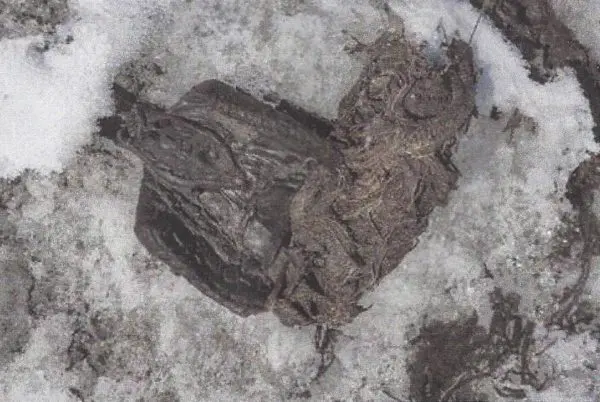
An ice free mule saddle made of cords and leather.
Sources: Mules and rock horses: animal bone remains, In: Providoli S., Curdy P. and Elsig P. (2015) 400 years in glacial ice. The Theodul Pass at Zermatt and his “mercenary”; NZZ: Glacier archaeology, stories from the freezer, Caroline Fink; www.ivs.admin.ch ; https://de.wikipedia.org/wiki/Theodulpass
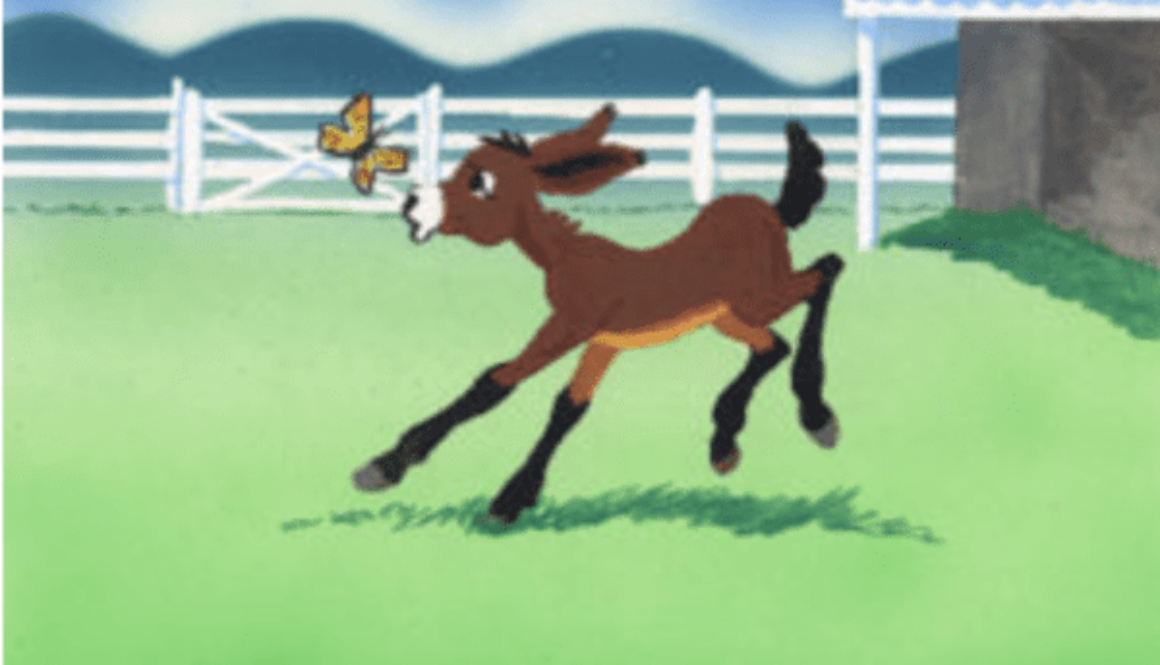
By Meredith Hodges
Hi, Meredith!
My name is Jasper. I am a three-year-old, 15HH, bay Quarter Horse mule. I suppose, by people standards, I’m really nothing special, but I’m still me! I heard my owners talking about you the other day. They said that if anyone could help set me straight, it would be you. I didn’t know there was a problem! I always try to do what they want me to, but sometimes that can be hard to figure out! When I was just a foal, people used to come out to see me and my mother.
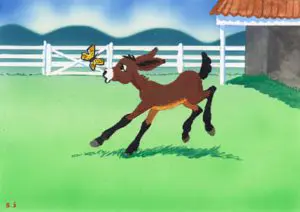 We were pastured on a couple of acres that surrounded an old shed where we used to get in out of the weather. My mother was content to graze and doze day after day – she wasn’t much on excitement. I used to love it when the people came and carried on about how cute I was. Then they would scratch and massage my fuzzy little body. They even got a little playful when I followed them around, romping, playing, and bumping them with my nose. “Oh, look how cute and friendly he is,” they’d say.
We were pastured on a couple of acres that surrounded an old shed where we used to get in out of the weather. My mother was content to graze and doze day after day – she wasn’t much on excitement. I used to love it when the people came and carried on about how cute I was. Then they would scratch and massage my fuzzy little body. They even got a little playful when I followed them around, romping, playing, and bumping them with my nose. “Oh, look how cute and friendly he is,” they’d say.
One day, when I was about six months old, the people came to play. I was feeling especially good that day and was glad to see some playmates coming to my pasture. Mom doesn’t really like to play much. I let them scratch and pet me for about 10 minutes, but then they started to leave! I didn’t want them to go, so I ran quickly behind one of the older men, nipped him on the butt playfully, and looped my forelegs over his shoulders. Wham! My whole head ached with the sting from that blow and I heard: “Get out of here, you brat!” I didn’t understand. They’d always liked to play before. “I guess we’ll have to start halter breaking this mule and teach him some manners!”
A few days went by before they came back. I was more cautious this time. I wanted to be scratched and loved, but I didn’t want to make them angry with me. Out of nowhere, they began trying to wrap this “thing” around my face! Didn’t even give me a chance to see or smell it! I felt trapped and scared to death! What were they going to do to me now?! Had I been worse than I had thought the other day? Did they want to kill me? I’d seen them whip and beat my mother one time when she wouldn’t go into that dark little room on wheels. She said it was best to do what they wanted, but that room was so small, she wasn’t sure she would fit, so she hesitated. “People don’t like it when you hesitate about doing what they ask, so try to perform quickly,” she said. My mother always helped me try to understand these humans and to appreciate the good things they have given us.
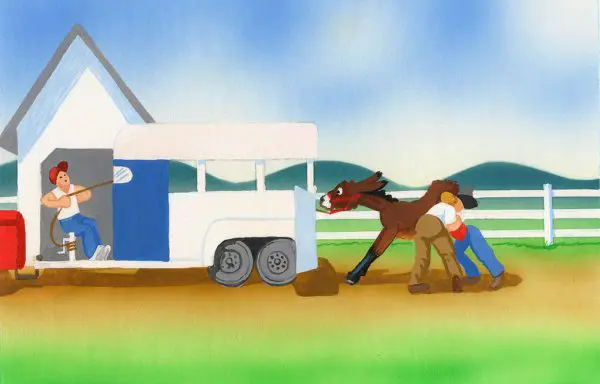 Suddenly, as soon as that “halter thing” was attached to my face, they tried to lead me away from my mother. That’s when I saw the little room on wheels parked along the pasture fence! I called to my mother to come… we were going for a ride! She took a couple of steps toward me when one of the two men shooed her off the other way. I was going alone with these two guys – but where?! Why?! I got scared! I pulled, kicked, bucked to get away, but nothing worked. They were both bigger than me and before long, I found myself locked in that little room on wheels… alone! I was frightened, but I was brave. The ride was short. When they finally opened the doors to let me out, I was an explosion of forced bravery. I came out of that trailer so fast I accidently knocked one of the men down. Whoops! Before I could show him how sorry I was, he jerked on my head and laced me about the head and neck with a long skinny stick that stung like a bee! Better stand still, I thought. Well, they didn’t like that either! They were pulling on my head and hitting me on the rear with that stinging stick! If I followed, it released the pressure from around my face and the man with the stick would stop, so I followed.
Suddenly, as soon as that “halter thing” was attached to my face, they tried to lead me away from my mother. That’s when I saw the little room on wheels parked along the pasture fence! I called to my mother to come… we were going for a ride! She took a couple of steps toward me when one of the two men shooed her off the other way. I was going alone with these two guys – but where?! Why?! I got scared! I pulled, kicked, bucked to get away, but nothing worked. They were both bigger than me and before long, I found myself locked in that little room on wheels… alone! I was frightened, but I was brave. The ride was short. When they finally opened the doors to let me out, I was an explosion of forced bravery. I came out of that trailer so fast I accidently knocked one of the men down. Whoops! Before I could show him how sorry I was, he jerked on my head and laced me about the head and neck with a long skinny stick that stung like a bee! Better stand still, I thought. Well, they didn’t like that either! They were pulling on my head and hitting me on the rear with that stinging stick! If I followed, it released the pressure from around my face and the man with the stick would stop, so I followed.
That was the first of my days in what they call training. They put me in a small house they called a stall. It had a small yard outside…large enough to walk around in, but not nearly enough room to romp and play. Whenever, the man came to take me out, I had hopes of finally getting a chance to stretch my legs and play a little, but every time I tried to play, he would only get angry with me and force me to stand still. Sometimes he would even tie me up and leave me alone for hours, which was worse than being in my stall! I tried to be good and do what he wanted, but there were always so many new things going on around me that I never really felt relaxed. Maybe, I wasn’t supposed to relax. Even the man who was training me seemed a little nervous and hesitant about how I would react. What was he nervous about? Why did he try to hide it? Is there something about all this that he wasn’t telling me? Will I get hurt?
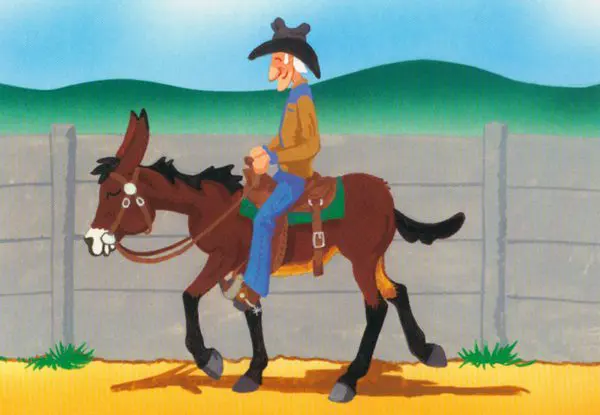 The day they put the saddle on my back when I was two was only one of many confusing times. I didn’t really mind the saddle until they fastened the belt around my middle so tight that I could hardly breathe. I bucked and ran, trying to get it off. “He’s going to be a real tough one,” the man said to my owner. I’m not really sure what he meant. I learned pretty quickly that the bucking only caused more pain as the stirrups thumped against my sensitive body. It was better to move smoothly with that saddle on my back, for sure. It took me awhile to learn to stop and turn when they pulled on that bit in my mouth, but the worst part was trying to keep my balance through all of this! Didn’t they know that I was still very young and growing and not really all that strong despite my size? They would ride me until I was stiff and sore, and then put me back in that small area with no room to stretch and exercise. They gave me rest for days at a time, with no other exercise. It seemed like I was either overworked or over-rested! My muscles never really had a chance to become stronger. They rode me either too long, or not at all. Somehow, though, I managed to learn. I guess we all do, whether it’s the hard way, or not.
The day they put the saddle on my back when I was two was only one of many confusing times. I didn’t really mind the saddle until they fastened the belt around my middle so tight that I could hardly breathe. I bucked and ran, trying to get it off. “He’s going to be a real tough one,” the man said to my owner. I’m not really sure what he meant. I learned pretty quickly that the bucking only caused more pain as the stirrups thumped against my sensitive body. It was better to move smoothly with that saddle on my back, for sure. It took me awhile to learn to stop and turn when they pulled on that bit in my mouth, but the worst part was trying to keep my balance through all of this! Didn’t they know that I was still very young and growing and not really all that strong despite my size? They would ride me until I was stiff and sore, and then put me back in that small area with no room to stretch and exercise. They gave me rest for days at a time, with no other exercise. It seemed like I was either overworked or over-rested! My muscles never really had a chance to become stronger. They rode me either too long, or not at all. Somehow, though, I managed to learn. I guess we all do, whether it’s the hard way, or not.
The reason that I am writing to you is to ask you to let mule owners know that we mules don’t mean to make mistakes. We love people! They know so many ways to have fun and they can be so pleasant and understanding when they want to be. I just wish that they didn’t think that we are deliberately trying to be bad. The only time I was ever “bad” is when I didn’t understand what they wanted. Even when I was stiff and sore and fed up… at least I tried!
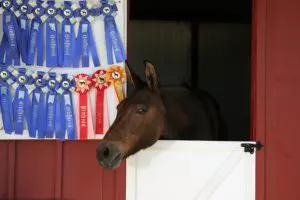 I met Mae Bea C.T. (“Peepers” from Jasper Goes to Bishop) and Ciji at Bishop Mule Days this year. They said that they have a wonderful life – equally balanced with training, pasture time, just plain fun and a lot of consideration for their feelings. Ciji said you were really mad at her for refusing all the jumps in the Hunter Under Saddle class, but that you were fair. You made her do them in the Jumping Class, rode the English Pleasure class and then let her rest for the remainder of the show since you knew she was in heat and had cramps. Ciji admitted that she can sometimes be a little stubborn and unfair herself, so she tried to make up for it by doing her best in the English Pleasure Class, which brought her fourth place.
I met Mae Bea C.T. (“Peepers” from Jasper Goes to Bishop) and Ciji at Bishop Mule Days this year. They said that they have a wonderful life – equally balanced with training, pasture time, just plain fun and a lot of consideration for their feelings. Ciji said you were really mad at her for refusing all the jumps in the Hunter Under Saddle class, but that you were fair. You made her do them in the Jumping Class, rode the English Pleasure class and then let her rest for the remainder of the show since you knew she was in heat and had cramps. Ciji admitted that she can sometimes be a little stubborn and unfair herself, so she tried to make up for it by doing her best in the English Pleasure Class, which brought her fourth place.
I wish my owners would be more fair with me. I’m only three years old, and they have already been riding me for a year! If they would only slow down and explain more carefully, maybe I wouldn’t make so many mistakes! Maybe if I had more play time, I wouldn’t get so impatient with their inability to explain… and if they would take time to learn to balance and control their own bodies, maybe they wouldn’t keep throwing me off balance when I am trying to comply. I really like my people and like most mules, I really want to please them. Bea and Ciji said you know how to speak “MULE.” Wish everybody did. It makes it easier to communicate when you speak the same language. Do you think you could teach more people to speak “MULE” so we can all enjoy our lives with our owners as much as your mules enjoy you? I hope so.
Sincerely yours,
JASPER
To learn more about Meredith Hodges and her comprehensive all-breed equine training program, visit LuckyThreeRanch.com, MEREDITH HODGES PUBLIC FIGURE Facebook page, or call 1-800-816-7566. Check out her children’s website at JasperTheMule.com. Also, find Meredith on Pinterest, Instagram, MeWe, YouTube and Twitter.
Covered in TRAINING MULES & DONKEY: A LOGICAL APPROACH TO TRAINING, TRAINING WITHOUT RESISTANCE, EQUUS REVISITED and A GUIDE TO RAISING & SHOWING MULES at www.luckythreeranchstore.com.
© 1990, 2016, 2024 Lucky Three Ranch, Inc. All Rights Reserved.
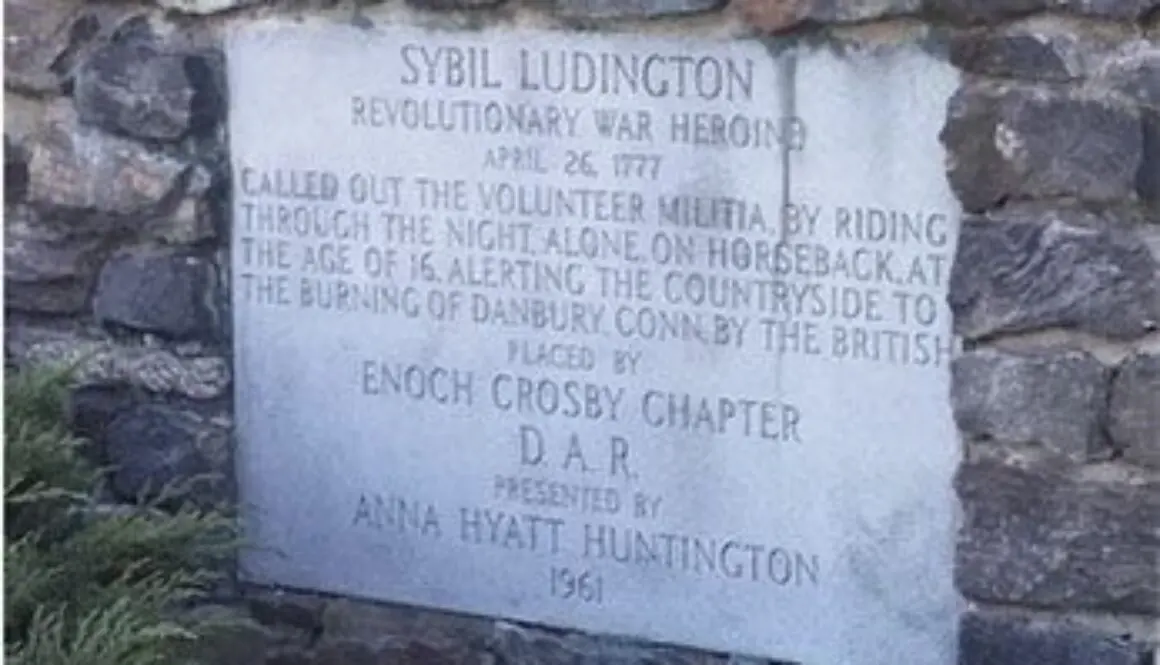
This article is a repost of Valerie DeBenedette‘s article at Mental Floss.
“… the midnight ride of Paul Revere, On the eighteenth of April, in Seventy-Five: Hardly a man is now alive …”
Yes, the famed Paul Revere set out on horseback on this day in 1775 to raise the alarm that British troops were on their way from Boston to Lexington.
 Revere rode about 20 miles through what is now Somerville, Medford, and Arlington, Massachusetts, knocking on doors to raise people to defend Lexington. Another rider, William Dawes, was sent by another route to do the same thing. A third, Samuel Prescott, was also pressed into service. Only Prescott completed the night’s work and reached Concord; Revere was captured and Dawes was thrown from his horse while evading British soldiers, forcing him to walk back to Lexington.
Revere rode about 20 miles through what is now Somerville, Medford, and Arlington, Massachusetts, knocking on doors to raise people to defend Lexington. Another rider, William Dawes, was sent by another route to do the same thing. A third, Samuel Prescott, was also pressed into service. Only Prescott completed the night’s work and reached Concord; Revere was captured and Dawes was thrown from his horse while evading British soldiers, forcing him to walk back to Lexington.
It was a good ride for Revere, and it was good for the revolution. But a little over two years later, a 16-year-old girl did the midnight riders one better. Sybil Ludington rode twice as far as Revere did, by herself, over bad roads, and in an area roamed by outlaws, to raise Patriot troops to fight in the Battle of Danbury and the Battle of Ridgefield in Connecticut. And did we mention it was raining?
Sybil was the eldest of 12 children of Col. Henry Ludington, the commander of the militia in Dutchess County, New York. Ludington’s farm was a receiving center for information collected by spies for the American cause.
In April 1777, Colonel Ludington and the members of his militia were at their homes because it was planting season. But about 9 p.m. on the evening of April 26, he received word that the British were burning Danbury. The man who brought the news had worn out his horse and he didn’t know the area. Ludington needed to stay where he was to help arrange the troops as they arrived.
Who could he send? He turned to his daughter, who knew the area and knew where members of the militia lived. Sybil rode her horse from her father’s farm in Kent, which was then called Frederick. She first headed south to the village of Carmel and then down to Mahopac. She turned west to Mahopac Falls and then north to Kent Cliffs and Farmers Mills. From there, she rode further north to Stormville, where she turned south to head back to her family’s farm. All told, she rode nearly 40 miles through what was then southern Dutchess County (which is now mostly Putnam County).
 Sybil spent the night traveling down narrow dirt roads in the rain with nothing but a stick as protection. To add another element of danger, there were many British loyalists in the area and more than a few “Skinners,” a word generally used then to describe an outlaw or ruffian who had no real loyalties to either side in the war. One account of her ride says that Sybil used her stick to pound on a Skinner who accosted her.
Sybil spent the night traveling down narrow dirt roads in the rain with nothing but a stick as protection. To add another element of danger, there were many British loyalists in the area and more than a few “Skinners,” a word generally used then to describe an outlaw or ruffian who had no real loyalties to either side in the war. One account of her ride says that Sybil used her stick to pound on a Skinner who accosted her.
By dawn, Sybil had made it back to her family farm where the militia men were gathering with her father. By this time, the British had gone south from Danbury to Ridgefield. The militia of Dutchess County, led by Colonel Ludington, marched 17 miles to Ridgefield and took part in the battle there, which some considered a strategic victory for the American forces.
Sybil’s hard riding earned her the congratulations of General George Washington, but it seems she got little recognition for her feat after that. She married another revolutionary, Edmond Ogden, in 1784 and had a child. At one point she and her husband ran a tavern in Catskill, New York, but she spent the last 40 years of her life as a widow until her death in 1839. She is buried near the route of her ride in Patterson, New York, with a headstone that spells her first name as Sibbell.
So why do we all learn about Paul Revere in our American history courses and not Sybil Ludington? In more recent times, Sybil has received a bit more acclaim for the ride that she made—there have been books written about her, a postage stamp near the bicentennial honoring her, and even a board game where players follow her overnight path. And in 1961, the local chapter of the Daughters of the American Revolution erected a larger-than-life statue of her on her horse in Carmel, New York.
Revere, of course, is justly honored as a man who served the Revolution in many capacities, including as a messenger and engraver (by trade, he was a fine silversmith). Perhaps his place in history was secured because he had Henry Wadsworth Longfellow serving as his publicist, with Longfellow’s famous (and famously inaccurate) poem—it leaves out both Dawes and Prescott—turning Revere into a legend. Sybil has no such fabled poem, no “one if by land, two if by sea” catchphrase. But perhaps as children we all should hear of the midnight ride of a teen with no fear.
All images courtesy Valerie DeBenedette.

By Meredith Hodges
In Part 1 of Rock and Roll: Diary of a Rescue, we learned about the discovery and rescue of Belgian draft mules, Rock and Roll, by Meredith Hodges and her team of experts. As the pair’s rehabilitation continues, the road to recovery gets tougher. But for every health setback, there is a personality breakthrough with these courageous and now-trusting gentle giants—and always a reason to hope.
By May of 2011, both mules were beginning to bond well with me and I was able to separate them during workouts. I knew I would have to develop a strong bond with Roll in case Rock didn’t make it, and we all knew the odds were not in Rock’s favor. Being alone with me in the round pen helped Roll to concentrate on the tasks at hand. His way of going was markedly improving with each new lesson.
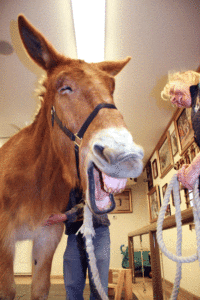 Both mules could now square up properly and move in a much more balanced frame, although holding that balance was intermittent. The personality of each mule began to emerge and they became more willing to play games and to be touched and kissed about their heads. Rock was much more overt about his pleasure during the massages, and we could finally tell that they were beginning to trust us.
Both mules could now square up properly and move in a much more balanced frame, although holding that balance was intermittent. The personality of each mule began to emerge and they became more willing to play games and to be touched and kissed about their heads. Rock was much more overt about his pleasure during the massages, and we could finally tell that they were beginning to trust us.
By mid-June, we were able to take the pads off Rock’s back feet and reset the shoes without the pads. He had grown three-eighths of an inch of sole on both hind feet and the rotation began to improve in one back foot. Both mules were feeling much better and were actually engaging in play during turnout. Next, we discovered that due to the concussion to his rear feet from improper use during driving in the past, Roll had side bones in his right hind foot. This caused him to twist that foot as it grew out between trims, so we put shoes on his back feet as well.
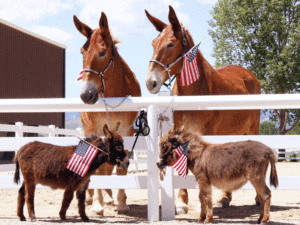 Rock loved our newly acquired mini donkeys and, during turnout, he would stand by their pen for the better part of the day. Here they all are on the Fourth of July, 2011.
Rock loved our newly acquired mini donkeys and, during turnout, he would stand by their pen for the better part of the day. Here they all are on the Fourth of July, 2011.
By that time, Rock and Roll were both looking magnificent! Considering the extent of Rock’s past neglect and injuries, he had gained incredible muscle tone and balance. His eyes were bright and alert, his coat was shiny and his feet were much improved (although they still exhibited a hint of chronic founder).
Roll’s fat and lumpy body had changed dramatically. Now his body was more symmetrical and balanced, and he also sported a shiny coat and balanced feet. His eyes were alert and his appearance of laziness had completely vanished.
However, by the end of July, Rock once again began to lose muscle tone over his right hip and his front feet became very sore. We thought he and Roll may have been playing too hard, which could have caused Rock to injure himself again, so we separated them into adjoining pastures during daily turnout. At night they remained in their respective stalls and runs, side by side. Custom-made boots were ordered for Rock’s front feet to help alleviate the pressure, but unfortunately we had to wait until the first of November for delivery of the boots. By the time they arrived, they were of use for only about two weeks before the weather changed. The wet snow and mud became packed in the boots, causing Rock too much pain on the dropped soles of his feet.
While Rock was on three weeks of rest during August, he developed swelling in his sheath. He was treated with an anti-inflammatory for two weeks, but the swelling didn’t go down. Since his front feet seemed better, I decided to resume his physical therapy. Although the structured movement helped the swelling go down, it migrated to the midline of his abdomen. After two weeks of hot packing the abdomen twice a day, the swelling finally disappeared. Because Rock was becoming stronger and getting up and down more often, he was beginning to develop sores on his knees, fetlocks and hocks, and “shoe boils” on his underbelly (pressure sores caused by his hooves when lying down), all of which needed to be frequently tended to.
In September, once again there was swelling on Rock’s underside midline, which also seemed to cause him to get weaker musculature in the hips. The swelling was hot-packed, and it disappeared fairly quickly this time. By mid-October, Rock was lying down for prolonged periods of time—unhealthy for an equine—so his support team of three veterinarians, two equine chiropractors, his equine masseuse and I got together to assess his condition. All 2000 plus pounds of his weight was being shifted off his three bad feet and onto his left hind leg, causing it to track behind the right front when he walked. We decided on a regimen of phenylbutazone (a non-steroidal anti-inflammatory drug), minimal 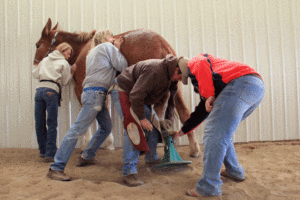 exercise, plenty of rest and icing of his feet for 15-20 minutes twice daily. Things were not looking good.
exercise, plenty of rest and icing of his feet for 15-20 minutes twice daily. Things were not looking good.
No matter what was asked of him, Rock always gave it his all. We babied him through turnout, chiropractics, trims, and massage, but it finally got to the point where we could barely get his back feet off the ground to apply the hoof dressing. We decided to remove his shoes. That day, he was so weak in the hindquarters we could not replace them and couldn’t even trim the feet without running the risk of him falling down. We waited a couple of weeks before we trimmed his heels with the aid of a custom-made, six-inch equine jack stand. That seemed to help through November and part of December, but Rock still needed the Thrush Buster and Rainmaker for hoof health. He was able to tip his hind feet forward and let us have the bottoms of his feet for a few seconds at a time so the medication could be applied. Finally, he just couldn’t manage having his feet elevated at all—the pain was too great. Around this time, we noticed that the swelling had again cropped up in his midline abdomen, which led to another week of hot packing it twice a day.
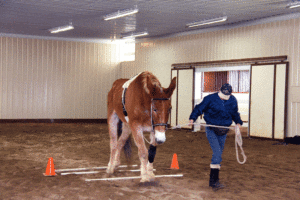 After Christmas, I decided to resume a modified version of his physical therapy. Trooper that he was, he tried with all his might, but his hips were listing terribly to the left, and the first time he went over the three one-inch ground poles, he crashed into every one of them. His third time over, he grazed just one. When I put him back in his pen, he immediately laid down. I then noticed the bulging in the coronet band of his left hind foot. He was “sinking!” We immediately called the vet and he confirmed my fear. The lamina was pulling away from the hoof wall and allowing the bones to “sink” through the sole of Rock’s hoof. It wouldn’t be long before the other feet would quickly follow suit. It was clear that he was in agony and would have to be put down, so our vet came out the ranch, loaded Rock up with anti-inflammatory and pain medications and said he would be back the next afternoon.
After Christmas, I decided to resume a modified version of his physical therapy. Trooper that he was, he tried with all his might, but his hips were listing terribly to the left, and the first time he went over the three one-inch ground poles, he crashed into every one of them. His third time over, he grazed just one. When I put him back in his pen, he immediately laid down. I then noticed the bulging in the coronet band of his left hind foot. He was “sinking!” We immediately called the vet and he confirmed my fear. The lamina was pulling away from the hoof wall and allowing the bones to “sink” through the sole of Rock’s hoof. It wouldn’t be long before the other feet would quickly follow suit. It was clear that he was in agony and would have to be put down, so our vet came out the ranch, loaded Rock up with anti-inflammatory and pain medications and said he would be back the next afternoon.
Every day for a year, I prayed for a miracle for Rock and each time I prayed, he got better. I now wondered if God would give us yet another miracle and let him live—but it wasn’t meant to be. On December 27th, 2011, surrounded by his Lucky Three family, our beautiful Rock took his last steps. We all knew it was time for us to let him go. Rock was euthanized at home and died peacefully, with his head resting in my hands.
My vet Greg Farrand informed me that the president of Colorado State University had pulled together a team for Rock’s necropsy and the preservation of his skeleton as a teaching aid for the CSU Veterinary Sciences department.
When the necropsy came back, it showed not a single fracture of Rock’s pelvis, but rather multiple old fractures in the socket of the hip joint. The bottom of the socket was almost completely gone and there was a hole the size of a dime at the top of the socket. The head of the femur had no cartilage left and there was fibrosis and cysts full of fluid the entire length of the femur stem.
I have come to realize that our courageous and noble Rock gave us more than one miracle. He had been able to live one more year of life with a severely shattered hip joint and compromised femur. He proved that our balance and core muscle therapy can work wonders! And he lived long enough to give his half-brother, Roll, the chance to bond with people who will love and care for him for the rest of his life. Thank you and God bless you, Rock. We will miss you.
To learn more about Meredith Hodges and her comprehensive all-breed equine training program, visit LuckyThreeRanch.com, MEREDITH HODGES PUBLIC FIGURE Facebook page, or call 1-800-816-7566. Check out her children’s website at JasperTheMule.com. Also, find Meredith on Pinterest, Instagram, MeWe, YouTube and Twitter.
© 2012, 2016, 2020 Lucky Three Ranch, Inc. All Rights Reserved.